-

Win a Free Custom Engraved Brass Coin!!!
As a way to introduce our brass coins to the community, we will raffle off a free coin during the month of August. Follow link ABOVE for instructions for entering.
You are using an out of date browser. It may not display this or other websites correctly.
You should upgrade or use an alternative browser.
You should upgrade or use an alternative browser.
Naval/Maritime History 27th of August - Today in Naval History - Naval / Maritime Events in History
14 August 1804 - Boats of HMS Galatea (1794 - 32), Cptn. Henry Heathcote, failed to cut out French privateer General Ernouf (late Lily) lying at the Saintes near Guadeloupe.
In February 1804 Galatea sailed to the West Indies as escort to a convoy of merchant vessels. On 19 May she recaptured Boyd, which was carrying plantation stores. A month later, on 25 June, she recaptured the English ship Beaver, which was carrying a cargo of slaves and ivory.
On 3 August the French privateer schooner Elizabeth, of six guns, arrived at Dominica. Galatea had cut her out at Guadeloupe.
The debacle
The next attempt to cut out a French vessel went badly. On 14 August Galatea attempted to cut out the French privateer Général Ernouf, which had been the British sloop-of-war Lilly). Général Ernouf was sheltering at the Saintesnear Guadeloupe where shore batteries could protect her. The attack was a debacle for the British, who failed completely in their attempt. Captain Heathcote had been too obvious in his reconnoitering and the French were waiting for the night attack. In all, the British lost some 10 men killed, including Lieutenant Charles Hayman, the commander of the boarding party, and first lieutenant of Galatea, and 55 or more wounded or captured. The French lost four killed and suffered some wounded, among them Captain Lapointe, commander of Général Ernouf, and Lieutenant Mouret, commander of the detachment of troops the French stationed aboard her in anticipation of the attack. The French also captured Galatea's barge, which the other three boats of the cutting out party could not retrieve as they made their escape.
The Ships
HMS Galatea was a fifth-rate 32-gun sailing frigate, Cerberus-class, of the British Royal Navy that George Parsons built at Bursledon and launched in 1794. Before she was broken up in 1809 she captured numerous prizes and participated in a number of actions, first in the Channel and off Ireland (1794–1803), and then in the Caribbean (1802–1809), including one that earned her crew the Naval General Service Medal.
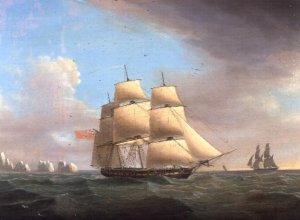
HMS Galatea, by Thomas Whitcombe
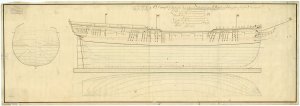



French privateer Général Ernouf was a 16-gun brig-sloop of the Royal Navy, formerly the civilian Sir Charles Grey. The Admiralty purchased her in 1795, after having hired her in 1793-94 under HMS Spencer, and renamed her HMS Lilly in 1800. The French privateer Dame Ambert captured her in 1804 and Lilly became the French privateer Général Ernouf. She blew up in 1805 while in an engagement with HMS Renard.
https://en.wikipedia.org/wiki/HMS_Galatea_(1794)
https://en.wikipedia.org/wiki/HMS_Spencer_(1795)
In February 1804 Galatea sailed to the West Indies as escort to a convoy of merchant vessels. On 19 May she recaptured Boyd, which was carrying plantation stores. A month later, on 25 June, she recaptured the English ship Beaver, which was carrying a cargo of slaves and ivory.
On 3 August the French privateer schooner Elizabeth, of six guns, arrived at Dominica. Galatea had cut her out at Guadeloupe.
The debacle
The next attempt to cut out a French vessel went badly. On 14 August Galatea attempted to cut out the French privateer Général Ernouf, which had been the British sloop-of-war Lilly). Général Ernouf was sheltering at the Saintesnear Guadeloupe where shore batteries could protect her. The attack was a debacle for the British, who failed completely in their attempt. Captain Heathcote had been too obvious in his reconnoitering and the French were waiting for the night attack. In all, the British lost some 10 men killed, including Lieutenant Charles Hayman, the commander of the boarding party, and first lieutenant of Galatea, and 55 or more wounded or captured. The French lost four killed and suffered some wounded, among them Captain Lapointe, commander of Général Ernouf, and Lieutenant Mouret, commander of the detachment of troops the French stationed aboard her in anticipation of the attack. The French also captured Galatea's barge, which the other three boats of the cutting out party could not retrieve as they made their escape.
The Ships
HMS Galatea was a fifth-rate 32-gun sailing frigate, Cerberus-class, of the British Royal Navy that George Parsons built at Bursledon and launched in 1794. Before she was broken up in 1809 she captured numerous prizes and participated in a number of actions, first in the Channel and off Ireland (1794–1803), and then in the Caribbean (1802–1809), including one that earned her crew the Naval General Service Medal.

HMS Galatea, by Thomas Whitcombe




French privateer Général Ernouf was a 16-gun brig-sloop of the Royal Navy, formerly the civilian Sir Charles Grey. The Admiralty purchased her in 1795, after having hired her in 1793-94 under HMS Spencer, and renamed her HMS Lilly in 1800. The French privateer Dame Ambert captured her in 1804 and Lilly became the French privateer Général Ernouf. She blew up in 1805 while in an engagement with HMS Renard.
https://en.wikipedia.org/wiki/HMS_Galatea_(1794)
https://en.wikipedia.org/wiki/HMS_Spencer_(1795)
14 August 1904 - The naval Battle off Ulsan - sinking of russian armed cruiser Rurik
(Japanese: 蔚山沖海戦 Urusan'oki kaisen; Russian: Бой в Корейском проливе, Boi v Koreiskom prolive), also known as the Battle of the Japanese Sea or Battle of the Korean Strait, took place on 14 August 1904 between cruiser squadrons of the Imperial Russian Navy and the Imperial Japanese Navy during the Russo-Japanese War, four days after the Battle of the Yellow Sea.

Sinking of the "Leulic", 14 Aug. Sinking of the Russian cruiser Rurik in the Battle off Ulsan during the Russo-Japanese War, 1904, from a contemporary propaganda postcard
Background
At the start of the Russo-Japanese War, the bulk of the Russian Pacific Fleet was blockaded within the confines of Port Arthur by the Imperial Japanese Navy. However, the Russian subsidiary naval base at Vladivostok, although shelled by a Japanese squadron under the command of Vice Admiral Dewa Shigetō in March 1904, remained largely undamaged. Located at Vladivostok was a garrison force consisting of the light cruiser Bogatyr and auxiliary cruiser Lena and a stronger Vladivostok Independent Cruiser Squadron consisting of the armored cruisers Rossia, Rurik, and Gromoboi. This force was under the command of Rear Admiral Karl Jessen from 15 March – 12 June 1904, Vice Admiral Petr Bezobrazov from 12 June – 16 October 1904 and from Jessen again from 15 October 1904 until the end of the war.
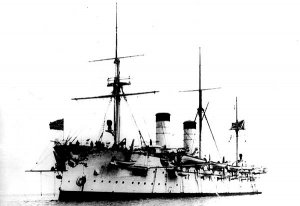
Rurik
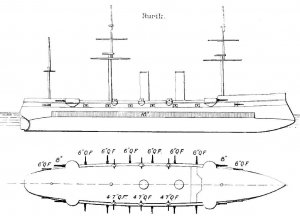
Simplified diagrams of the Rurik, as depicted in Brassey's Naval Annual 1902

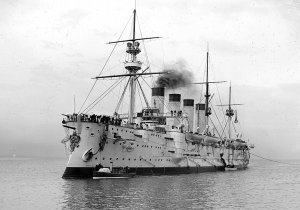
Russian armored cruiser Rossia after her 1906 rebuild / The Imperial Russian armoured cruiser Gromoboy
Commerce raiding operations
The Vladivostok Independent Cruiser Squadron made a total of six sorties from Vladivostok for commerce raiding in 1904, sinking a total of 15 transports. The first raid was from 9 to 14 February along the coast of Japan, in which a single transport was sunk. The second was from 24 February to 1 March along the coast of Korea without any results. However, during the third raid from 23 to 27 April, the Russian squadron ambushed Japanese troop transports approaching Gensan in Korea, causing considerable damage. The fourth raid from 12 to 19 June sank several transports in the Tsushima Strait in what was called the "Hitachi Maru Incident", and resulted in the capture of a British transport, Allantown. This was followed by the fifth raid from 28 June – 3 July, again in the Tsushima Strait, in which the British transport Cheltenham was captured. Finally on 17 July to 1 August, the Russian squadron raided the Pacific coast of Japan, sinking one British and one German freighter. As a result of these operations, the Japanese were forced to assign the IJN 2nd Fleet under the command of Vice Admiral Kamimura Hikonojō with considerable resources in an attempt to locate and destroy the Russian squadron. Kamimura's failure to do so on several occasions created considerable adverse public comment in Japan.
Sortie
A telegram from the First Pacific Squadron at Port Arthur reached Vladivostok on the afternoon of 11 August 1904, stating that Admiral Wilgelm Vitgeft had decided to attempt to break through the Japanese blockade, and therefore Vice Admiral Jessen was ordered to sortie the Vladivostok Cruiser Squadron to assist. However, as late as 5 August 1904, a telegram had been received from Vitgeft stating his intention to perish with Port Arthur, so the Vladivostok cruisers took time to get ready for action. Owing to the delay in sailing, there was little hope of being able to assist the First Pacific Squadron at the critical passage of the Tsushima Straits; however on the assumption that Vitgeft would be successful, the two squadrons planned to rendezvous in the Sea of Japan.
The warships of the Vladivostok Cruiser Squadron formed in a line abreast at intervals of 4 nautical miles (7.4 km) and headed southward at 14 knots (26 km/h), in hourly expectation of sighting the Port Arthur Squadron. However, the Port Arthur Squadron had not been sighted by the following morning. As the Vladivostok Cruiser Squadron approached Busan, Jessen advised his captains that he had no intention of attempting to pass Tsushima Straits, and ordered the squadron back to Vladivostok.
The Japanese 2nd Fleet under Admiral Kamimura was made up of four armored cruisers Izumo, Azuma, Tokiwa, Iwate, and two protected cruisers Naniwa and Takachiho. The Japanese squadron had passed very close to the Russian squadron in the dark of the previous night on opposite courses but neither was aware of the other. From 01:30 on 14 August 1904, Kamimura had been heading back from his night patrol area on a course that took him directly to the Russian squadron. When Jessen started his turn back to Vladivostok, he sighted the four Japanese armored cruisers.


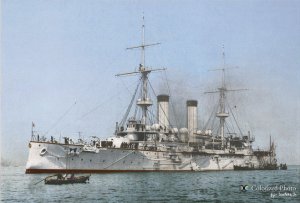
Japanese cruiser Izumo / Japanese cruiser Azuma / Japanese cruiser Tokiwa
The situation was ideal for the Japanese side. It was dawn on a fine summer day, and the enemy was as far from Vladivostok as it was possible to be in the Sea of Japan, with the Japanese squadron between themselves and their distant base.
The battle
At 05:20 on 14 August 1904 the fleets had closed to 7,800 metres (25,600 ft), and the Japanese opened fire first. For unknown reasons, Kamimura ordered fire concentrated on Rurik, the last and weakest in the Russian column. Subjected to twice the bombardment administered to her stronger comrades, Rurik lost most of her officers in a short time, and although extremely damaged, remained afloat, the diminishing number of survivors continuing to fire the few remaining guns until the very last, in a gallant display of classic heroism that won the admiration of the Japanese.
On the easterly run the Japanese ships took some hits, but nothing comparable to what they inflicted. It was assumed that when the Russians sheered away, Kamimura would have pressed his advantage closer. Inexplicably, this did not happen. Kamimura oddly held his course during the Russian turn, and when he ordered his forces to turn a few minutes later, it was to a new tack that actually lengthened rather than narrowed the range.
The remaining Russian cruisers tried to cover Rurik, but with increasing damage, Jessen decided at 08:30 to scuttle Rurik, and save his other ships by heading back towards Vladivostok. The Japanese cruisers pursued for some time, and firing continued, with more damage to the Russian cruisers and slight damage to Iwate and Azuma. The Russians were in a far worse condition than the Japanese, but Kamimura then made another controversial decision: after pursuit of only three hours, while still on the high seas, and with long daylight steaming hours between the Japanese cruisers and Vladivostok, at 11:15 he broke off the chase, and turned back towards Busan.
Despite Kamimura's failure to destroy the two remaining Russian cruisers, he was hailed as a hero in Japan. Although two of the three Russian cruisers escaped, their damage was greater than what the limited repair facilities at Vladivostok could handle, and the Vladivostok Cruiser Squadron never threatened Japanese shipping again.
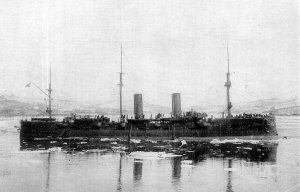
Rurik in 1904 with cut down rig
Russian point of view
From the Imperial Russian Navy's point of view, Rurik was scuttled by her own crew, not by Admiral Jessen's decision. Rurik was hit by a shell in her unarmored stern and the steering mechanism was destroyed, immobilizing her rudder in an elevated position. So the maximum speed of Rurik had been greatly reduced and her steering had to be performed by reducing the revolutions of each one of her propellers. Jessen successfully diverted all four Japanese armored cruisers and hoped that Rurik could stand against Naniwa and Takachiho. However, the condition of Rurik was rather bad. First Rank Captain Trusov, her commander, and all senior officers were killed. Finally, Lieutenant Ivanov (the thirteenth in command) ordered Rurik to be scuttled.


Built by Jim Baumann (http://www.steelnavy.com/CombrigRurikJB.htm)
Rossia and Gromoboi successfully repelled the attack of Kamimura's cruisers at the price of sustaining heavy damage, but IRN sailors, while still under fire, were able to repair the main 203 mm (8 in) guns and continue to engage with them. Faced with an increasing rate of fire from the Russian cruisers and with his ammunition supplies nearly depleted, Admiral Kamimura decided to stop pursuit.
The very heavy Russian casualties suffered in the battle were the result of two factors: the bursting charges in Japanese shells was picric acid (trinitrophenol) which on detonation turned the shells into very large numbers of fragments. Additionally the Russian ships lacked protective gun shields for the crews.
Order of battle
Ship order is according to their position in line
Russia
Vladivostok Cruiser Force - Rear Admiral Karl Jessen:
Japan
2nd Fleet - Vice Admiral Kamimura Hikonojō
https://en.wikipedia.org/wiki/Battle_off_Ulsan
https://en.wikipedia.org/wiki/Russian_cruiser_Rurik_(1892)
(Japanese: 蔚山沖海戦 Urusan'oki kaisen; Russian: Бой в Корейском проливе, Boi v Koreiskom prolive), also known as the Battle of the Japanese Sea or Battle of the Korean Strait, took place on 14 August 1904 between cruiser squadrons of the Imperial Russian Navy and the Imperial Japanese Navy during the Russo-Japanese War, four days after the Battle of the Yellow Sea.

Sinking of the "Leulic", 14 Aug. Sinking of the Russian cruiser Rurik in the Battle off Ulsan during the Russo-Japanese War, 1904, from a contemporary propaganda postcard
Background
At the start of the Russo-Japanese War, the bulk of the Russian Pacific Fleet was blockaded within the confines of Port Arthur by the Imperial Japanese Navy. However, the Russian subsidiary naval base at Vladivostok, although shelled by a Japanese squadron under the command of Vice Admiral Dewa Shigetō in March 1904, remained largely undamaged. Located at Vladivostok was a garrison force consisting of the light cruiser Bogatyr and auxiliary cruiser Lena and a stronger Vladivostok Independent Cruiser Squadron consisting of the armored cruisers Rossia, Rurik, and Gromoboi. This force was under the command of Rear Admiral Karl Jessen from 15 March – 12 June 1904, Vice Admiral Petr Bezobrazov from 12 June – 16 October 1904 and from Jessen again from 15 October 1904 until the end of the war.

Rurik

Simplified diagrams of the Rurik, as depicted in Brassey's Naval Annual 1902


Russian armored cruiser Rossia after her 1906 rebuild / The Imperial Russian armoured cruiser Gromoboy
Commerce raiding operations
The Vladivostok Independent Cruiser Squadron made a total of six sorties from Vladivostok for commerce raiding in 1904, sinking a total of 15 transports. The first raid was from 9 to 14 February along the coast of Japan, in which a single transport was sunk. The second was from 24 February to 1 March along the coast of Korea without any results. However, during the third raid from 23 to 27 April, the Russian squadron ambushed Japanese troop transports approaching Gensan in Korea, causing considerable damage. The fourth raid from 12 to 19 June sank several transports in the Tsushima Strait in what was called the "Hitachi Maru Incident", and resulted in the capture of a British transport, Allantown. This was followed by the fifth raid from 28 June – 3 July, again in the Tsushima Strait, in which the British transport Cheltenham was captured. Finally on 17 July to 1 August, the Russian squadron raided the Pacific coast of Japan, sinking one British and one German freighter. As a result of these operations, the Japanese were forced to assign the IJN 2nd Fleet under the command of Vice Admiral Kamimura Hikonojō with considerable resources in an attempt to locate and destroy the Russian squadron. Kamimura's failure to do so on several occasions created considerable adverse public comment in Japan.
Sortie
A telegram from the First Pacific Squadron at Port Arthur reached Vladivostok on the afternoon of 11 August 1904, stating that Admiral Wilgelm Vitgeft had decided to attempt to break through the Japanese blockade, and therefore Vice Admiral Jessen was ordered to sortie the Vladivostok Cruiser Squadron to assist. However, as late as 5 August 1904, a telegram had been received from Vitgeft stating his intention to perish with Port Arthur, so the Vladivostok cruisers took time to get ready for action. Owing to the delay in sailing, there was little hope of being able to assist the First Pacific Squadron at the critical passage of the Tsushima Straits; however on the assumption that Vitgeft would be successful, the two squadrons planned to rendezvous in the Sea of Japan.
The warships of the Vladivostok Cruiser Squadron formed in a line abreast at intervals of 4 nautical miles (7.4 km) and headed southward at 14 knots (26 km/h), in hourly expectation of sighting the Port Arthur Squadron. However, the Port Arthur Squadron had not been sighted by the following morning. As the Vladivostok Cruiser Squadron approached Busan, Jessen advised his captains that he had no intention of attempting to pass Tsushima Straits, and ordered the squadron back to Vladivostok.
The Japanese 2nd Fleet under Admiral Kamimura was made up of four armored cruisers Izumo, Azuma, Tokiwa, Iwate, and two protected cruisers Naniwa and Takachiho. The Japanese squadron had passed very close to the Russian squadron in the dark of the previous night on opposite courses but neither was aware of the other. From 01:30 on 14 August 1904, Kamimura had been heading back from his night patrol area on a course that took him directly to the Russian squadron. When Jessen started his turn back to Vladivostok, he sighted the four Japanese armored cruisers.



Japanese cruiser Izumo / Japanese cruiser Azuma / Japanese cruiser Tokiwa
The situation was ideal for the Japanese side. It was dawn on a fine summer day, and the enemy was as far from Vladivostok as it was possible to be in the Sea of Japan, with the Japanese squadron between themselves and their distant base.
The battle
At 05:20 on 14 August 1904 the fleets had closed to 7,800 metres (25,600 ft), and the Japanese opened fire first. For unknown reasons, Kamimura ordered fire concentrated on Rurik, the last and weakest in the Russian column. Subjected to twice the bombardment administered to her stronger comrades, Rurik lost most of her officers in a short time, and although extremely damaged, remained afloat, the diminishing number of survivors continuing to fire the few remaining guns until the very last, in a gallant display of classic heroism that won the admiration of the Japanese.
On the easterly run the Japanese ships took some hits, but nothing comparable to what they inflicted. It was assumed that when the Russians sheered away, Kamimura would have pressed his advantage closer. Inexplicably, this did not happen. Kamimura oddly held his course during the Russian turn, and when he ordered his forces to turn a few minutes later, it was to a new tack that actually lengthened rather than narrowed the range.
The remaining Russian cruisers tried to cover Rurik, but with increasing damage, Jessen decided at 08:30 to scuttle Rurik, and save his other ships by heading back towards Vladivostok. The Japanese cruisers pursued for some time, and firing continued, with more damage to the Russian cruisers and slight damage to Iwate and Azuma. The Russians were in a far worse condition than the Japanese, but Kamimura then made another controversial decision: after pursuit of only three hours, while still on the high seas, and with long daylight steaming hours between the Japanese cruisers and Vladivostok, at 11:15 he broke off the chase, and turned back towards Busan.
Despite Kamimura's failure to destroy the two remaining Russian cruisers, he was hailed as a hero in Japan. Although two of the three Russian cruisers escaped, their damage was greater than what the limited repair facilities at Vladivostok could handle, and the Vladivostok Cruiser Squadron never threatened Japanese shipping again.

Rurik in 1904 with cut down rig
Russian point of view
From the Imperial Russian Navy's point of view, Rurik was scuttled by her own crew, not by Admiral Jessen's decision. Rurik was hit by a shell in her unarmored stern and the steering mechanism was destroyed, immobilizing her rudder in an elevated position. So the maximum speed of Rurik had been greatly reduced and her steering had to be performed by reducing the revolutions of each one of her propellers. Jessen successfully diverted all four Japanese armored cruisers and hoped that Rurik could stand against Naniwa and Takachiho. However, the condition of Rurik was rather bad. First Rank Captain Trusov, her commander, and all senior officers were killed. Finally, Lieutenant Ivanov (the thirteenth in command) ordered Rurik to be scuttled.


Built by Jim Baumann (http://www.steelnavy.com/CombrigRurikJB.htm)
Rossia and Gromoboi successfully repelled the attack of Kamimura's cruisers at the price of sustaining heavy damage, but IRN sailors, while still under fire, were able to repair the main 203 mm (8 in) guns and continue to engage with them. Faced with an increasing rate of fire from the Russian cruisers and with his ammunition supplies nearly depleted, Admiral Kamimura decided to stop pursuit.
The very heavy Russian casualties suffered in the battle were the result of two factors: the bursting charges in Japanese shells was picric acid (trinitrophenol) which on detonation turned the shells into very large numbers of fragments. Additionally the Russian ships lacked protective gun shields for the crews.
Order of battle
Ship order is according to their position in line
Russia
Vladivostok Cruiser Force - Rear Admiral Karl Jessen:
Japan
2nd Fleet - Vice Admiral Kamimura Hikonojō
- 2nd Unit: armored cruisers:
- 4th Unit: protected cruisers:
https://en.wikipedia.org/wiki/Battle_off_Ulsan
https://en.wikipedia.org/wiki/Russian_cruiser_Rurik_(1892)
Other Events on 14 August
1592 – The first sighting of the Falkland Islands by John Davis
https://en.wikipedia.org/wiki/John_Davis_(English_explorer)
1744 – Launch of HMS Fowey, fifth rate
HMS Fowey was a fifth rate warship of the Royal Navy, launched on 14 August 1744 in Hull, England. She spent only four years in commission before she struck a reef and sank in what is known today as Legare age in Biscayne National Park, off the coast of Florida. She was armed with six, nine, and eighteen pounder guns and crewed with over 200 men.
age in Biscayne National Park, off the coast of Florida. She was armed with six, nine, and eighteen pounder guns and crewed with over 200 men.
https://en.wikipedia.org/wiki/HMS_Fowey_(1744)
1764 – Launch of French Utile, 56 gun shio of Bordelois class
https://en.wikipedia.org/wiki/French_ship_Utile_(1764)
https://en.wikipedia.org/wiki/Bordelois-class_ship_of_the_line
1799 - HMS Fox (1780 – 32 gun Active class), and HMS Daedalus (1780 – 32 gun Active class),and boats destroyed Kosseir.
https://en.wikipedia.org/wiki/HMS_Fox_(1780)
https://en.wikipedia.org/wiki/HMS_Daedalus_(1780)
1806 -HMS Phosphorus Fireship (4), Lt. W. J. Hughes, beat off a French privateer lugger (12) off the Isle of Wight.
1809 - Boats of HMS Otter (18), Nisbet Josiah Willoughby, captured two vessels in the Indian Ocean.
1812 - HMS Chubb Schooner(4), Lt. Samuel Nisbett, foundered near Halifax.
1814 - HMS Nancy (3) burnt in Nottawasaga river to avoid capture by Americans
1828 – Launch of HMS Comus 18-gun sloop, name ship of her class “Comet-class”
https://en.wikipedia.org/wiki/HMS_Comus_(1828)
1870 – Death of David Farragut
David Glasgow Farragut /ˈfærəɡət/ (also spelled Glascoe; July 5, 1801 – August 14, 1870) was a flag officer of the United States Navy during the American Civil War. He was the first rear admiral, vice admiral, and admiral in the United States Navy. He is remembered for his order at the Battle of Mobile Bay usually paraphrased as "Damn the torpedoes, full speed ahead" in U.S. Navy tradition.
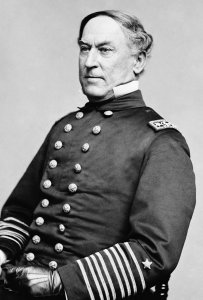
Born near Knoxville, Tennessee, Farragut was fostered by naval officer David Porter after the death of his mother. Despite his young age, Farragut served in the War of 1812 under the command of his adoptive father. He received his first command in 1824 and participated in anti-piracy operations in the Caribbean Sea. He served in the Mexican–American War under the command of Matthew C. Perry, participating in the blockade of Tuxpan. After the war, he oversaw the construction of the Mare Island Naval Shipyard, the first U.S. Navy base established on the Pacific Ocean.
Though Farragut resided in Norfolk, Virginia prior to the Civil War, he was a Southern Unionist who strongly opposed Southern secession and remained loyal to the Union after the outbreak of the Civil War. Despite some doubts about Farragut's loyalty, Farragut was assigned command of an attack on the important Confederate port city of New Orleans. After fighting past Fort St. Philip and Fort Jackson, Farragut captured New Orleans in April 1862. He was promoted to rear admiral after the battle and helped extend Union control up along the Mississippi River, participating in the Siege of Port Hudson. With the Union in control of the Mississippi, Farragut led a successful attack on Mobile Bay, home to the last major Confederate port on the Gulf of Mexico. Farragut was promoted to Admiral following the end of the Civil War and remained on active duty until his death in 1870.
https://en.wikipedia.org/wiki/David_Farragut
1888 - collision of the S/S Geiser and S/S Thingvalla, both ocean liners of which were owned and operated by the Thingvalla Line.. 118 people died
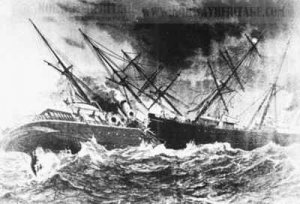



https://de.wikipedia.org/wiki/Geiser_(Schiff,_1881)
http://www.norwayheritage.com/p_shiplist.asp?co=thing
https://en.wikipedia.org/wiki/Thingvalla_Line
1969 - the exploration submarine Ben Franklin under command of Jacques Piccard ended the successfull 30-days voyage of oceanographic study in the depths of the Gulf Stream
The Ben Franklin mesoscaphe, also known as the Grumman/Piccard PX-15, was a manned underwater submersible built in 1968. It was the brainchild of explorer and inventor Jacques Piccard. The research vessel was designed to house a six-man crew for up to 30 days of oceanographic study in the depths of the Gulf Stream. NASA became involved, seeing this as an opportunity to study the effects of long-term, continuous close confinement, a useful simulation of long space flights.
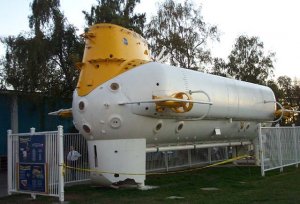

The Ben Franklin was built between 1966 and 1968 at the Giovanola fabrication plant in Monthey, Switzerland by Piccard and the Grumman Aircraft Engineering Corporation headed by Donald B Terrana, then disassembled and shipped to Florida. The vessel is the first submarine to be built to American Bureau of Shipping (ABS) standards. With a design crush depth of 4,000 feet (1,200 m), it was designed to drift along at neutral buoyancy at depths between 600 and 2,000 feet (180 and 610 metres). The 130-ton ship has four external electric propulsion pods, primarily used for altitude trimming. It is powered by tons of lead batteriesstored outside the hull. Its length is 48 feet 9 inches (14.86 m), with a beam of 21 feet 6 inches (6.55 m) and a height of 20 feet (6.1 m). Piccard insisted on 29 observation portholes, despite the objections of engineers over the inclusion of potentially fatal weak points.
It began its voyage on July 14, 1969, off Palm Beach, Florida, with Piccard as the mission leader. Accompanied by surface support vessels, it resurfaced on August 14, 1,444 miles (2,324 km) away, 300 miles (480 km) south of Halifax, Nova Scotia, Canada. The Ben Franklin made a few more dives after 1969, including the first deep-sea dive for Robert Ballard, the discoverer of the wreck of the Titanic.
After running aground on a reef in 1971, the Ben Franklin was sold to Vancouver businessman John Horton, only to languish for nearly three decades on the North Shore. In December 1999, with a sudden decision to either move or scrap the submersible, it was offered to the Vancouver Maritime Museum. After refurbishment, the submersible was placed in front of the museum.
https://en.wikipedia.org/wiki/Ben_Franklin_(PX-15)
1592 – The first sighting of the Falkland Islands by John Davis
https://en.wikipedia.org/wiki/John_Davis_(English_explorer)
1744 – Launch of HMS Fowey, fifth rate
HMS Fowey was a fifth rate warship of the Royal Navy, launched on 14 August 1744 in Hull, England. She spent only four years in commission before she struck a reef and sank in what is known today as Legare
 age in Biscayne National Park, off the coast of Florida. She was armed with six, nine, and eighteen pounder guns and crewed with over 200 men.
age in Biscayne National Park, off the coast of Florida. She was armed with six, nine, and eighteen pounder guns and crewed with over 200 men.https://en.wikipedia.org/wiki/HMS_Fowey_(1744)
1764 – Launch of French Utile, 56 gun shio of Bordelois class
https://en.wikipedia.org/wiki/French_ship_Utile_(1764)
https://en.wikipedia.org/wiki/Bordelois-class_ship_of_the_line
1799 - HMS Fox (1780 – 32 gun Active class), and HMS Daedalus (1780 – 32 gun Active class),and boats destroyed Kosseir.
https://en.wikipedia.org/wiki/HMS_Fox_(1780)
https://en.wikipedia.org/wiki/HMS_Daedalus_(1780)
1806 -HMS Phosphorus Fireship (4), Lt. W. J. Hughes, beat off a French privateer lugger (12) off the Isle of Wight.
1809 - Boats of HMS Otter (18), Nisbet Josiah Willoughby, captured two vessels in the Indian Ocean.
1812 - HMS Chubb Schooner(4), Lt. Samuel Nisbett, foundered near Halifax.
1814 - HMS Nancy (3) burnt in Nottawasaga river to avoid capture by Americans
1828 – Launch of HMS Comus 18-gun sloop, name ship of her class “Comet-class”
https://en.wikipedia.org/wiki/HMS_Comus_(1828)
1870 – Death of David Farragut
David Glasgow Farragut /ˈfærəɡət/ (also spelled Glascoe; July 5, 1801 – August 14, 1870) was a flag officer of the United States Navy during the American Civil War. He was the first rear admiral, vice admiral, and admiral in the United States Navy. He is remembered for his order at the Battle of Mobile Bay usually paraphrased as "Damn the torpedoes, full speed ahead" in U.S. Navy tradition.

Born near Knoxville, Tennessee, Farragut was fostered by naval officer David Porter after the death of his mother. Despite his young age, Farragut served in the War of 1812 under the command of his adoptive father. He received his first command in 1824 and participated in anti-piracy operations in the Caribbean Sea. He served in the Mexican–American War under the command of Matthew C. Perry, participating in the blockade of Tuxpan. After the war, he oversaw the construction of the Mare Island Naval Shipyard, the first U.S. Navy base established on the Pacific Ocean.
Though Farragut resided in Norfolk, Virginia prior to the Civil War, he was a Southern Unionist who strongly opposed Southern secession and remained loyal to the Union after the outbreak of the Civil War. Despite some doubts about Farragut's loyalty, Farragut was assigned command of an attack on the important Confederate port city of New Orleans. After fighting past Fort St. Philip and Fort Jackson, Farragut captured New Orleans in April 1862. He was promoted to rear admiral after the battle and helped extend Union control up along the Mississippi River, participating in the Siege of Port Hudson. With the Union in control of the Mississippi, Farragut led a successful attack on Mobile Bay, home to the last major Confederate port on the Gulf of Mexico. Farragut was promoted to Admiral following the end of the Civil War and remained on active duty until his death in 1870.
https://en.wikipedia.org/wiki/David_Farragut
1888 - collision of the S/S Geiser and S/S Thingvalla, both ocean liners of which were owned and operated by the Thingvalla Line.. 118 people died




https://de.wikipedia.org/wiki/Geiser_(Schiff,_1881)
http://www.norwayheritage.com/p_shiplist.asp?co=thing
https://en.wikipedia.org/wiki/Thingvalla_Line
1969 - the exploration submarine Ben Franklin under command of Jacques Piccard ended the successfull 30-days voyage of oceanographic study in the depths of the Gulf Stream
The Ben Franklin mesoscaphe, also known as the Grumman/Piccard PX-15, was a manned underwater submersible built in 1968. It was the brainchild of explorer and inventor Jacques Piccard. The research vessel was designed to house a six-man crew for up to 30 days of oceanographic study in the depths of the Gulf Stream. NASA became involved, seeing this as an opportunity to study the effects of long-term, continuous close confinement, a useful simulation of long space flights.


The Ben Franklin was built between 1966 and 1968 at the Giovanola fabrication plant in Monthey, Switzerland by Piccard and the Grumman Aircraft Engineering Corporation headed by Donald B Terrana, then disassembled and shipped to Florida. The vessel is the first submarine to be built to American Bureau of Shipping (ABS) standards. With a design crush depth of 4,000 feet (1,200 m), it was designed to drift along at neutral buoyancy at depths between 600 and 2,000 feet (180 and 610 metres). The 130-ton ship has four external electric propulsion pods, primarily used for altitude trimming. It is powered by tons of lead batteriesstored outside the hull. Its length is 48 feet 9 inches (14.86 m), with a beam of 21 feet 6 inches (6.55 m) and a height of 20 feet (6.1 m). Piccard insisted on 29 observation portholes, despite the objections of engineers over the inclusion of potentially fatal weak points.
It began its voyage on July 14, 1969, off Palm Beach, Florida, with Piccard as the mission leader. Accompanied by surface support vessels, it resurfaced on August 14, 1,444 miles (2,324 km) away, 300 miles (480 km) south of Halifax, Nova Scotia, Canada. The Ben Franklin made a few more dives after 1969, including the first deep-sea dive for Robert Ballard, the discoverer of the wreck of the Titanic.
After running aground on a reef in 1971, the Ben Franklin was sold to Vancouver businessman John Horton, only to languish for nearly three decades on the North Shore. In December 1999, with a sudden decision to either move or scrap the submersible, it was offered to the Vancouver Maritime Museum. After refurbishment, the submersible was placed in front of the museum.
https://en.wikipedia.org/wiki/Ben_Franklin_(PX-15)
Thanks for posting these Uwe.
Hallo @Anthony
many thanks for the interest on this topic..... it is worth to read something about the time and history of all these ships we are building.
And sometimes it is also a deversification from the usual Building logs, modeling hints and kits etc ......
I will continue.....there are only appr. 300 days more until I have completed the days of a year
(started with the events on 12th June).... so it will be a very long thread.....and for you still a lot to read
15 August 1807 - Action between HMS Comus vs. Fredrickscoarn
General
HMS Comus was a 22-gun Laurel-class sixth-rate post ship of the Royal Navy. She was launched in 1806. In 1807 she took part in one notable single-ship action and was at the capture of Copenhagen. In 1815 she spent six months with the West Africa Squadron suppressing the slave trade during which time she captured ten slavers and freed 500-1000 slaves. She was wrecked in 1816, though with no loss of life.
Action
Comus was under Captain Edward Heywood from July 1807, and in August she was with the expedition to Copenhagen. During this service she took part in a notable, illegal and ultimately one-sided single-ship action, and accumulated substantial prize money.
On 12 August the 32-gun Danish frigate Frederiksværn (Fredrickscoarn in British usage), sailed for Norway from Elsinor and Admiral Lord Gambier sent the 74-gun third rate Defence and Comus after her, even though war had not yet been declared. Comus was faster than Defence in the light winds and so outdistanced her.
On 14 August 1807 Comus sighted Frederiksværn and chased her, catching up off Marstrand a little before midnight on the 15th. Heywood ordered the Frederiksværn to halt and allow herself to be detained.[8] War not having been declared, and Frederiksværn being a naval vessel, she ignored Heywood's instructions. Heywood ordered a musket fired, to which Frederiksværn replied with a shot from her stern guns. Comus followed with a broadside.
After an action of 45 minutes, Frederiksværn's rigging was disabled. Comus and Frederiksværn then came together, which enabled a boarding party from Comus to climb over Frederiksværn's bow and capture her.
The two vessels had been relatively evenly matched in firepower. Comus's broadside weighed 204 pounds, while Frederiksværn's broadside weighed 200 pounds.[8] However, Frederiksværn had a crew of 226 men to Comus's 145 men. Still, the British had suffered only one man wounded. The Danes lost 12 men killed and 20 wounded, some mortally. The Royal Navy took her into service as Frederickscoarn.
Defence and Comus then sailed in search of a Danish 74-gun reported to be returning to Copenhagen, but did not find her. On 18 August Comus captured the Danish merchant vessel Haabet.
Comus went on to participate in the capitulation of Copenhagen on 7 September and to share in the prize money for that. Comus also shared with Christian VII in the recapture on the same day of the Britannia. Three days later Comus shared with Spencer and Pelican in the capture of the Danish merchant vessel Fredeus Forsward. Later that month, on 9 September, Comus and Pelican captured the Danish merchant vessel Elizabeth vonder Pahlen, but had to share with Defence, which was in sight. Three days after that, on 2 October, Comus and Pelican captured the Danish merchant vessel Anna Catherina.
Dimensions of danish frigate Frederiksværn
Length: 127' (danish) / 130' 10'' (imperial)
Breadth: 36' (danish) / 37' 1'' (imperial)
Depth in Hold: 17' 2'' (danish) / 17' 8'' (imperial)
Draught Foreward 14' 2'' (imperial)
Draught Aft 15' 2'' (imperial)
Height of middle gunport above the water 6' 2'' (imperial)
L/B Ratio 3,53
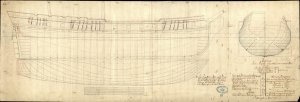
Armament:
26* danish 12-pounders
10* danish 4-pounders (later replaced by 12-pounder carronades)
Designed by H. Gerner, probably Denmark's most eminent shipwright in the 18th century, Friderichsværn was one of seven ships of the Bornholm-class. Launched 1784 and captured by HMS Comus before the 2nd Battle of Copenhagen. Sold 1814.
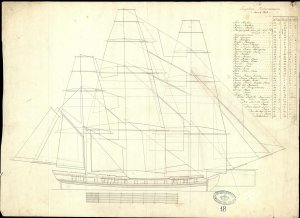
Other ships in class:
Bornholm (1774, only 24 12-pounder on the upper deck)
Kiel (1775)
Moen (1777)
St. Thomas (1779)
Cronborg (1781)
Det Store Belt (1782)
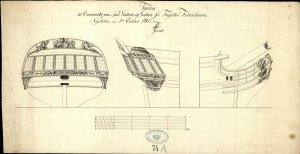
https://en.wikipedia.org/wiki/HMS_Comus_(1806)
https://en.wikipedia.org/wiki/Battle_of_Copenhagen_(1807)
General
HMS Comus was a 22-gun Laurel-class sixth-rate post ship of the Royal Navy. She was launched in 1806. In 1807 she took part in one notable single-ship action and was at the capture of Copenhagen. In 1815 she spent six months with the West Africa Squadron suppressing the slave trade during which time she captured ten slavers and freed 500-1000 slaves. She was wrecked in 1816, though with no loss of life.
Action
Comus was under Captain Edward Heywood from July 1807, and in August she was with the expedition to Copenhagen. During this service she took part in a notable, illegal and ultimately one-sided single-ship action, and accumulated substantial prize money.
On 12 August the 32-gun Danish frigate Frederiksværn (Fredrickscoarn in British usage), sailed for Norway from Elsinor and Admiral Lord Gambier sent the 74-gun third rate Defence and Comus after her, even though war had not yet been declared. Comus was faster than Defence in the light winds and so outdistanced her.
On 14 August 1807 Comus sighted Frederiksværn and chased her, catching up off Marstrand a little before midnight on the 15th. Heywood ordered the Frederiksværn to halt and allow herself to be detained.[8] War not having been declared, and Frederiksværn being a naval vessel, she ignored Heywood's instructions. Heywood ordered a musket fired, to which Frederiksværn replied with a shot from her stern guns. Comus followed with a broadside.
After an action of 45 minutes, Frederiksværn's rigging was disabled. Comus and Frederiksværn then came together, which enabled a boarding party from Comus to climb over Frederiksværn's bow and capture her.
The two vessels had been relatively evenly matched in firepower. Comus's broadside weighed 204 pounds, while Frederiksværn's broadside weighed 200 pounds.[8] However, Frederiksværn had a crew of 226 men to Comus's 145 men. Still, the British had suffered only one man wounded. The Danes lost 12 men killed and 20 wounded, some mortally. The Royal Navy took her into service as Frederickscoarn.
Defence and Comus then sailed in search of a Danish 74-gun reported to be returning to Copenhagen, but did not find her. On 18 August Comus captured the Danish merchant vessel Haabet.
Comus went on to participate in the capitulation of Copenhagen on 7 September and to share in the prize money for that. Comus also shared with Christian VII in the recapture on the same day of the Britannia. Three days later Comus shared with Spencer and Pelican in the capture of the Danish merchant vessel Fredeus Forsward. Later that month, on 9 September, Comus and Pelican captured the Danish merchant vessel Elizabeth vonder Pahlen, but had to share with Defence, which was in sight. Three days after that, on 2 October, Comus and Pelican captured the Danish merchant vessel Anna Catherina.
Dimensions of danish frigate Frederiksværn
Length: 127' (danish) / 130' 10'' (imperial)
Breadth: 36' (danish) / 37' 1'' (imperial)
Depth in Hold: 17' 2'' (danish) / 17' 8'' (imperial)
Draught Foreward 14' 2'' (imperial)
Draught Aft 15' 2'' (imperial)
Height of middle gunport above the water 6' 2'' (imperial)
L/B Ratio 3,53

Armament:
26* danish 12-pounders
10* danish 4-pounders (later replaced by 12-pounder carronades)
Designed by H. Gerner, probably Denmark's most eminent shipwright in the 18th century, Friderichsværn was one of seven ships of the Bornholm-class. Launched 1784 and captured by HMS Comus before the 2nd Battle of Copenhagen. Sold 1814.

Other ships in class:
Bornholm (1774, only 24 12-pounder on the upper deck)
Kiel (1775)
Moen (1777)
St. Thomas (1779)
Cronborg (1781)
Det Store Belt (1782)

https://en.wikipedia.org/wiki/HMS_Comus_(1806)
https://en.wikipedia.org/wiki/Battle_of_Copenhagen_(1807)
15 August 1895 - The battleship USS Texas is commissioned. She is the first American steel-hulled battleship.
USS Texas was a second-class battleship built by the United States in the early 1890s, the first American battleship commissioned[1] and the first ship named in honor of the state of Texas to be built by the United States.[a] Built in reaction to the acquisition of modern armored warships by several South American countries, Texas was meant to incorporate the latest developments in naval tactics and design. This includes the mounting of her main armament en echelon to allow maximum end-on fire and a heavily-armored redoubt amidships to ensure defensive strength. However, due to the state of U.S. industry at the time, Texas's building time was lengthy, and by the time she was commissioned, she was already out of date. Nevertheless, she and her near-sister USS Maine were considered advancements in American naval design.
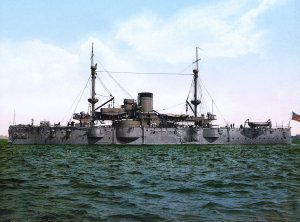
USS Texas in 1898 (commissioned 1892)
Texas developed a reputation as a jinxed or unlucky ship after several accidents early in her career; she consequently earned the nickname "Old Hoodoo".[1] These mishaps included problems during construction, a grounding off Newport, Rhode Island, and flooding shortly afterwards while at dock in New York City. In the last, she settled to the bottom with her gun deck awash and several crew members drowned. She also received significant damage to her hull in drydock after being raised. Her reputation improved with her service in the Spanish–American War,[2] when she blockaded the coast of Cuba and fought in the Battle of Santiago de Cuba.
After the war, Texas returned to peacetime duty, interrupted by several refits. She became the station ship in Charleston, South Carolina, by 1908 and was renamed San Marcos in 1911 to allow her name to be used by a new battleship. She became a target ship that same year and was sunk in shallow water in Chesapeake Bay. She was used as a gunnery target through World War II and was finally demolished in 1959 because her remains were considered a navigational hazard.
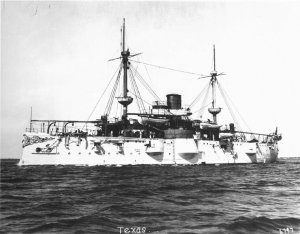
Texas prior to the Spanish–American War
https://en.wikipedia.org/wiki/USS_Texas_(1892)
USS Texas was a second-class battleship built by the United States in the early 1890s, the first American battleship commissioned[1] and the first ship named in honor of the state of Texas to be built by the United States.[a] Built in reaction to the acquisition of modern armored warships by several South American countries, Texas was meant to incorporate the latest developments in naval tactics and design. This includes the mounting of her main armament en echelon to allow maximum end-on fire and a heavily-armored redoubt amidships to ensure defensive strength. However, due to the state of U.S. industry at the time, Texas's building time was lengthy, and by the time she was commissioned, she was already out of date. Nevertheless, she and her near-sister USS Maine were considered advancements in American naval design.

USS Texas in 1898 (commissioned 1892)
Texas developed a reputation as a jinxed or unlucky ship after several accidents early in her career; she consequently earned the nickname "Old Hoodoo".[1] These mishaps included problems during construction, a grounding off Newport, Rhode Island, and flooding shortly afterwards while at dock in New York City. In the last, she settled to the bottom with her gun deck awash and several crew members drowned. She also received significant damage to her hull in drydock after being raised. Her reputation improved with her service in the Spanish–American War,[2] when she blockaded the coast of Cuba and fought in the Battle of Santiago de Cuba.
After the war, Texas returned to peacetime duty, interrupted by several refits. She became the station ship in Charleston, South Carolina, by 1908 and was renamed San Marcos in 1911 to allow her name to be used by a new battleship. She became a target ship that same year and was sunk in shallow water in Chesapeake Bay. She was used as a gunnery target through World War II and was finally demolished in 1959 because her remains were considered a navigational hazard.

Texas prior to the Spanish–American War
https://en.wikipedia.org/wiki/USS_Texas_(1892)
15 August 1914 – The Panama Canal opens to traffic with the transit of the cargo ship SS Ancon.

SS Ancon entering west chamber, Mira Flores lower locks, Panama Canal
SS Ancon was an American cargo and passenger ship that became the first ship to officially transit the Panama Canal in 1914. The ship was built as Shawmut for the Boston Steamship Company by the Maryland Steel Company, Sparrows Point, Maryland and put into Pacific service operating out of Puget Sound ports for Japan, China and the Philippine Islands. Shawmut and sister ship Tremont were two of the largest United States commercial ships in service at the time and the company eventually found them too expensive to operate.
Shawmut and Tremont were acquired by the United States Government through the agency of the Panama Railroad Company's Panama Railroad Steamship Line, whose assets were entirely owned by the government and critical to construction of the canal, to serve between New York and the Atlantic terminus during canal construction. Both ships were renamed for features of the canal; Shawmut for the Pacific side terminus Ancon and Tremontas Cristobal for the Canal's Atlantic port. Though not the first vessel to make a complete transit, Ancon made the first official and ceremonial transit with a delegation of some two hundred dignitaries aboard. After the end of World War I the ship saw very brief service from 28 March to 25 July 1919 as a commissioned United States Ship, USS Ancon (ID-1467), making two round trip voyages from the New York Port of Embarkation to France returning troops home. Ancon was returned to Panama Canal service and was in service with the canal until 1939 when the ship was sold to private parties known as the Permanente Steamship Company and renamed Permanente.
The Panama Canal service
In 1909 the ship was purchased by the Panama Canal. The ship was renamed for the Panama Canal's Pacific side terminus at Ancon. Both Ancon and her sister ship Cristobal operated under The Panama Railroad Company's Panama Railroad Steamship Line. Both ships played a crucial role in building the canal, bringing workers and supplies, notably massive amounts of cement, from New York to Panama for the construction project.
On 15 August 1914 Ancon made the first official transit of the canal as part the canal's opening ceremonies. (Her sister ship Cristobal had made the first unofficial transit on 3 August, delivering a load of cement, while an old French crane boat Alexandre La Valley had crossed the canal from the Atlantic in stages during construction, finally reaching the Pacific on 7 January.)
Five days after the end of World War I, on 16 November 1918, Ancon was acquired at New Orleans by the United States Navy from the Department of War (Army) and commissioned on 28 March 1919 under the command of Lt. Comdr. Milan L. Pittman, USNRF as the troop transport USS Ancon (ID-1467). The ship was assigned to the Atlantic Fleet's Cruiser and Transport Force making two round-trip voyages from the United States to France returning troops home. On completion of the second voyage Ancon was decommissioned at New York City on 25 July 1919 and returned to the War Department.
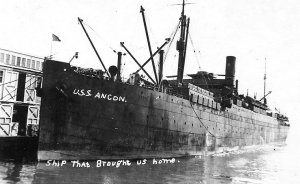
USS Ancon (ID-1467) in port in 1919, while engaged in transporting U.S. troops home from Europe.
The Panama Railroad Company replaced SS Ancon in 1938 with a larger steam turbine cargo liner named Ancon which later saw considerable action as the Navy command and communications ship USS Ancon (AGC-4) in World War II. The old Ancon remained in Panama Canal service as Ex Ancon until sold private.
https://en.wikipedia.org/wiki/SS_Ancon_(1901)
https://en.wikipedia.org/wiki/Panama_Canal

SS Ancon entering west chamber, Mira Flores lower locks, Panama Canal
SS Ancon was an American cargo and passenger ship that became the first ship to officially transit the Panama Canal in 1914. The ship was built as Shawmut for the Boston Steamship Company by the Maryland Steel Company, Sparrows Point, Maryland and put into Pacific service operating out of Puget Sound ports for Japan, China and the Philippine Islands. Shawmut and sister ship Tremont were two of the largest United States commercial ships in service at the time and the company eventually found them too expensive to operate.
Shawmut and Tremont were acquired by the United States Government through the agency of the Panama Railroad Company's Panama Railroad Steamship Line, whose assets were entirely owned by the government and critical to construction of the canal, to serve between New York and the Atlantic terminus during canal construction. Both ships were renamed for features of the canal; Shawmut for the Pacific side terminus Ancon and Tremontas Cristobal for the Canal's Atlantic port. Though not the first vessel to make a complete transit, Ancon made the first official and ceremonial transit with a delegation of some two hundred dignitaries aboard. After the end of World War I the ship saw very brief service from 28 March to 25 July 1919 as a commissioned United States Ship, USS Ancon (ID-1467), making two round trip voyages from the New York Port of Embarkation to France returning troops home. Ancon was returned to Panama Canal service and was in service with the canal until 1939 when the ship was sold to private parties known as the Permanente Steamship Company and renamed Permanente.
The Panama Canal service
In 1909 the ship was purchased by the Panama Canal. The ship was renamed for the Panama Canal's Pacific side terminus at Ancon. Both Ancon and her sister ship Cristobal operated under The Panama Railroad Company's Panama Railroad Steamship Line. Both ships played a crucial role in building the canal, bringing workers and supplies, notably massive amounts of cement, from New York to Panama for the construction project.
On 15 August 1914 Ancon made the first official transit of the canal as part the canal's opening ceremonies. (Her sister ship Cristobal had made the first unofficial transit on 3 August, delivering a load of cement, while an old French crane boat Alexandre La Valley had crossed the canal from the Atlantic in stages during construction, finally reaching the Pacific on 7 January.)
Five days after the end of World War I, on 16 November 1918, Ancon was acquired at New Orleans by the United States Navy from the Department of War (Army) and commissioned on 28 March 1919 under the command of Lt. Comdr. Milan L. Pittman, USNRF as the troop transport USS Ancon (ID-1467). The ship was assigned to the Atlantic Fleet's Cruiser and Transport Force making two round-trip voyages from the United States to France returning troops home. On completion of the second voyage Ancon was decommissioned at New York City on 25 July 1919 and returned to the War Department.

USS Ancon (ID-1467) in port in 1919, while engaged in transporting U.S. troops home from Europe.
The Panama Railroad Company replaced SS Ancon in 1938 with a larger steam turbine cargo liner named Ancon which later saw considerable action as the Navy command and communications ship USS Ancon (AGC-4) in World War II. The old Ancon remained in Panama Canal service as Ex Ancon until sold private.
https://en.wikipedia.org/wiki/SS_Ancon_(1901)
https://en.wikipedia.org/wiki/Panama_Canal
15 August 1940 – An Italian submarine Delfino torpedoes and sinks the Greek cruiser Elli at Tinos harbor during peacetime, marking the most serious Italian provocation prior to the outbreak of the Greco-Italian War in October.
Elli (Greek: Κ/Δ Έλλη) was a 2,600 ton Greek protected cruiser (Greek: Εύδρομο Καταδρομικό) named for a naval battle of the First Balkan War in which Greece was victorious. She was completed in 1913 and commissioned in 1914. Elli saw action during World War I and in the disastrous Asia Minor Expedition. An Italian submarine sank her, before the outbreak of the Greco-Italian War on 15 August 1940 while she sat at anchor.
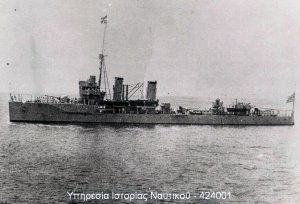
Elli
History
She was originally one of three cruisers of the ill-fated Chao Ho class. The Chinese government ordered her built as the Fei Hong (Chinese: 飛鴻; pinyin: Féi Hóng; Wade–Giles: Fei Hung; literally: "Flying Swan"), however, the Nationalist revolution in 1912–13 resulted in the Chinese government cancelling the purchase. New York Shipbuilding in the United States completed her in 1914 and sold her to Greece, which purchased her as part of its program of naval expansion after the Balkan Wars.
Elli saw action during World War I. Initially during the war, Greece followed a course of neutrality, with the Prime Minister Eleftherios Venizelos favoring the Entente and pro-German King Constantine I advocating neutrality. This dispute eventually led to a deep political conflict, known as the "National Schism". In November 1916, in order to apply pressure on the royal government in Athens, the French confiscated the Greek ships. They continued to operate with French crews, primarily in convoy escort and patrol duties in the Aegean, until Greece entered the war on the side of the Allies in June 1917, at which point they were returned to Greece. Subsequently, the Greek Navy took part in the Allied operations in the Aegean.
In 1920 she underwent a reconstruction in France, along with the armored cruiser Georgios Averof. In that reconstruction she obtained modern anti-aircraft armament and the equipment to carry and lay 100 sea mines.
In the disastrous Asia Minor Expedition, the future King Paul of Greece was a sub-Lieutenant on board Elli and witnessed the evacuation of Smyrna in September 1922.
Fate and aftermath
The Italian submarine Delfino sank her during peacetime, at 8:25 am on 15 August 1940, while she rode at anchor near the island of Tinos. Elli was in Tinos participating in the celebrations of the Feast of the Dormition of the Theotokos. One of the three torpedoes fired hit Elli under the one operating boiler and she caught fire and sank. Nine petty officers and sailors were killed and 24 were wounded. The same submarine attempted to torpedo the passenger ships MV Elsi and MV Esperos anchored in the port. This attempt failed and the torpedoes damaged only a section of the port's wharf.
Fragments of the torpedoes were recovered and identified as Italian in origin. The Greek government however, trying to avoid a confrontation with Italy at the time, announced that the nationality of the attacking submarine was unknown, an act that did not forestall the outbreak of the Greco-Italian War two months later, and did not convince the Greek people who were well aware of the perpetrator.
After the war, as compensation for the sinking of Elli, Italy gave Greece the cruiser Eugenio di Savoia which was commissioned in June 1950 for the Royal Hellenic Navy with the name Elli. She served until 1973. Since 1982, a Standard-class frigate, Elli, the lead ship of the Elli class, has continued the name.
Delfino (English: Dolphin) was a Squalo-class submarine that served in the Italian Regia Marina during the Spanish Civil War and World War II. She was named after the Delfino of 1892, the first ever Italian submarine. She was laid down on 27 October 1928, at the Cantieri Riuniti dell'Adriatico (CRDA) shipyard at Monfalcone. She was launched on 27 April 1930 and delivered to the Navy on 19 June 1931.
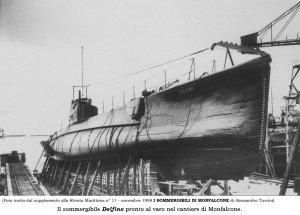
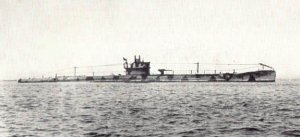
Il Regio Sommergibile Delfino, della classe Squalo, varato nel 1930
https://en.wikipedia.org/wiki/Greek_cruiser_Elli_(1912)
https://en.wikipedia.org/wiki/Italian_submarine_Delfino_(1930)
https://en.wikipedia.org/wiki/Chao_Ho-class_cruiser
Elli (Greek: Κ/Δ Έλλη) was a 2,600 ton Greek protected cruiser (Greek: Εύδρομο Καταδρομικό) named for a naval battle of the First Balkan War in which Greece was victorious. She was completed in 1913 and commissioned in 1914. Elli saw action during World War I and in the disastrous Asia Minor Expedition. An Italian submarine sank her, before the outbreak of the Greco-Italian War on 15 August 1940 while she sat at anchor.

Elli
History
She was originally one of three cruisers of the ill-fated Chao Ho class. The Chinese government ordered her built as the Fei Hong (Chinese: 飛鴻; pinyin: Féi Hóng; Wade–Giles: Fei Hung; literally: "Flying Swan"), however, the Nationalist revolution in 1912–13 resulted in the Chinese government cancelling the purchase. New York Shipbuilding in the United States completed her in 1914 and sold her to Greece, which purchased her as part of its program of naval expansion after the Balkan Wars.
Elli saw action during World War I. Initially during the war, Greece followed a course of neutrality, with the Prime Minister Eleftherios Venizelos favoring the Entente and pro-German King Constantine I advocating neutrality. This dispute eventually led to a deep political conflict, known as the "National Schism". In November 1916, in order to apply pressure on the royal government in Athens, the French confiscated the Greek ships. They continued to operate with French crews, primarily in convoy escort and patrol duties in the Aegean, until Greece entered the war on the side of the Allies in June 1917, at which point they were returned to Greece. Subsequently, the Greek Navy took part in the Allied operations in the Aegean.
In 1920 she underwent a reconstruction in France, along with the armored cruiser Georgios Averof. In that reconstruction she obtained modern anti-aircraft armament and the equipment to carry and lay 100 sea mines.
In the disastrous Asia Minor Expedition, the future King Paul of Greece was a sub-Lieutenant on board Elli and witnessed the evacuation of Smyrna in September 1922.
Fate and aftermath
The Italian submarine Delfino sank her during peacetime, at 8:25 am on 15 August 1940, while she rode at anchor near the island of Tinos. Elli was in Tinos participating in the celebrations of the Feast of the Dormition of the Theotokos. One of the three torpedoes fired hit Elli under the one operating boiler and she caught fire and sank. Nine petty officers and sailors were killed and 24 were wounded. The same submarine attempted to torpedo the passenger ships MV Elsi and MV Esperos anchored in the port. This attempt failed and the torpedoes damaged only a section of the port's wharf.
Fragments of the torpedoes were recovered and identified as Italian in origin. The Greek government however, trying to avoid a confrontation with Italy at the time, announced that the nationality of the attacking submarine was unknown, an act that did not forestall the outbreak of the Greco-Italian War two months later, and did not convince the Greek people who were well aware of the perpetrator.
After the war, as compensation for the sinking of Elli, Italy gave Greece the cruiser Eugenio di Savoia which was commissioned in June 1950 for the Royal Hellenic Navy with the name Elli. She served until 1973. Since 1982, a Standard-class frigate, Elli, the lead ship of the Elli class, has continued the name.
Delfino (English: Dolphin) was a Squalo-class submarine that served in the Italian Regia Marina during the Spanish Civil War and World War II. She was named after the Delfino of 1892, the first ever Italian submarine. She was laid down on 27 October 1928, at the Cantieri Riuniti dell'Adriatico (CRDA) shipyard at Monfalcone. She was launched on 27 April 1930 and delivered to the Navy on 19 June 1931.


Il Regio Sommergibile Delfino, della classe Squalo, varato nel 1930
https://en.wikipedia.org/wiki/Greek_cruiser_Elli_(1912)
https://en.wikipedia.org/wiki/Italian_submarine_Delfino_(1930)
https://en.wikipedia.org/wiki/Chao_Ho-class_cruiser
15 August 1942 – World War II: Operation Pedestal: The SS Ohio reaches the island of Malta barely afloat carrying vital fuel supplies for the island's defenses.
The SS Ohio was an oil tanker built for the Texas Oil Company (now Texaco). The ship was launched on 20 April 1940 at the Sun Shipbuilding & Drydock Co. in Chester, Pennsylvania. She was requisitioned by the Allied forces to re-supply the island fortress of Malta during the Second World War.

The damaged tanker OHIO, supported by Royal Navy destroyers, approaches Malta after an epic voyage across the Mediterranean as part of convoy WS21S (en:Operation Pedestal) to deliver fuel and other vital supplies to the besieged island. OHIO's back was broken and her engines failed during heavy German and Italian attacks. Because of the vital importance of her cargo (10,000 tons of fuel which would enable the aircraft and submarines based at Malta to return to the offensive), she could not be abandoned. In a highly unusual manoeuvre, two destroyers supported her to provide buoyancy and power for the remainder of the voyage. The OHIO's captain was subsequently awarded the George Cross. The OHIO itself was sunk outside the harbour after discharging its cargo.
The tanker played a fundamental role in Operation Pedestal, which was one of the fiercest and most heavily contested of the Malta convoys, in August 1942. Although Ohio reached Malta successfully, she was so badly damaged that she had to be effectively scuttled in order to offload her cargo, and never sailed again. The tanker is fondly remembered in Malta, where to this day she is considered to be the savior of the beleaguered island.
READ THE COMPLETE INTERESTING STORY ON WIKIPEDIA !!!
https://en.wikipedia.org/wiki/SS_Ohio
https://en.wikipedia.org/wiki/Operation_Pedestal
The SS Ohio was an oil tanker built for the Texas Oil Company (now Texaco). The ship was launched on 20 April 1940 at the Sun Shipbuilding & Drydock Co. in Chester, Pennsylvania. She was requisitioned by the Allied forces to re-supply the island fortress of Malta during the Second World War.

The damaged tanker OHIO, supported by Royal Navy destroyers, approaches Malta after an epic voyage across the Mediterranean as part of convoy WS21S (en:Operation Pedestal) to deliver fuel and other vital supplies to the besieged island. OHIO's back was broken and her engines failed during heavy German and Italian attacks. Because of the vital importance of her cargo (10,000 tons of fuel which would enable the aircraft and submarines based at Malta to return to the offensive), she could not be abandoned. In a highly unusual manoeuvre, two destroyers supported her to provide buoyancy and power for the remainder of the voyage. The OHIO's captain was subsequently awarded the George Cross. The OHIO itself was sunk outside the harbour after discharging its cargo.
The tanker played a fundamental role in Operation Pedestal, which was one of the fiercest and most heavily contested of the Malta convoys, in August 1942. Although Ohio reached Malta successfully, she was so badly damaged that she had to be effectively scuttled in order to offload her cargo, and never sailed again. The tanker is fondly remembered in Malta, where to this day she is considered to be the savior of the beleaguered island.
READ THE COMPLETE INTERESTING STORY ON WIKIPEDIA !!!
https://en.wikipedia.org/wiki/SS_Ohio
https://en.wikipedia.org/wiki/Operation_Pedestal
Other Events on 15 August
1281 – Mongol invasion of Japan: The Mongolian fleet of Kublai Khan is destroyed by a "divine wind" for the second time in the Battle of Kōan.
The Battle of Kōan (弘安の役 Kōan no eki), also known as the Second Battle of Hakata Bay, was the second attempt by the Mongolian Yuan Dynastyto invade Japan after their failed attempt seven years earlier at the Battle of Bun'ei. In the summer of 1281 the Yuan invaded with two large armies. The Japanese defenders were aided by a major storm which sunk a sizeable portion of the Mongolian fleets. The invaders who reached the shore were repulsed shortly after landing. The Japanese called the opportune storm kamikaze ("divine wind"), a name that was used in the Second World War for pilots who carried out aerial suicide attacks.

Mooko-SamuraiShips
https://en.wikipedia.org/wiki/Battle_of_Kōan
https://en.wikipedia.org/wiki/Mongol_invasions_of_Japan
1517 – Seven Portuguese armed vessels led by Fernão Pires de Andrade meet Chinese officials at the Pearl River estuary.
Captain Fernão Pires de Andrade (also spelled as Fernão Peres de Andrade; in contemporary sources, Fernam (Fernã) Perez Dandrade) (died 1552)was a Portuguese merchant, pharmacist, and official diplomat under the explorer and Portuguese Malacca governor Afonso de Albuquerque. His encounter with Ming China in 1517—after initial contacts by Jorge Álvares and Rafael Perestrello in 1513 and 1516, respectively—marked the resumption of direct European commercial and diplomatic contact with China. (Even though there were Europeans in Medieval China, notably Marco Polo, that period of contact had been interrupted by the fall of the Yuan dynasty.) Although de Andrade's mission was initially a success that allowed a Portuguese embassy to proceed all the way to Beijing, relations were soon spoiled by culminating events that led to an extremely negative impression of the Portuguese in China. This included acts of his brother Simão that enraged the Chinese, false reports of the Portuguese being cannibals of kidnapped Chinese children and true reports of their conquest of Malacca, a loyal Ming tributary state. Normalized trade and relations between Portugal and the Ming dynasty would not resume until the late 1540s and the 1557 establishment of Portuguese rule over Macau.
Andrade was referred to as a "Folangji" (佛郎機) in Ming dynastic archives. Folangji comes from Franques or Franks, which was a generic name the Muslims called Europeans since the Crusades, and which spawned the Indian-Southeast Asian term ferengi. The Chinese adopted the convention when they first thought the Portuguese were related to those Muslim guides and interpreters during Fernão's first encounter and before Europeans directly convened with Chinese.

The Zhengde Emperor, who accepted the Portuguese embassy but died before he could finalize relations with Portugal, hence dooming the embassy as conservative factions at court in Beijing were aligned against those who conquered the Ming's loyal tributary vassal in Malacca.
https://en.wikipedia.org/wiki/Fernão_Pires_de_Andrade
1779 - French and Spanish fleets off Plymouth.
1797 - HMS Alexandrian Schooner (6), Lt. William Wood Senhouse, captured French privateer schooner Coq (6) off Martinique.
1815 - HMS Dominica Schooner (14), Lt. Richard Crawford, wrecked off Bermuda.
1944 - Operation Dragoon begins, which is the Allied invasion of Southern France. Western Naval Task Force, commanded by Vice Adm. Henry K. Hewitt, USN, lands the Allied force on the front between Toulon and Cannes.
Operation Dragoon (initially Operation Anvil) was the code name for the Allied invasion of Southern France on 15 August 1944. The operation was initially to take place in conjunction with Operation Overlord, the Allied landing in Normandy, but a lack of resources led to cancellation of the second landing. By July 1944 the landing was reconsidered, as the ports of Normandy did not have the capacity to adequately supply Allied forces. Concurrently, the French High Command pushed for a revival of the operation that would include large numbers of French troops. As a result, the operation was finally approved in July to be executed in August.
The goal of the operation was to secure vital ports on the French Mediterranean coast and increase pressure on German forces by opening a second front. After some preliminary commando operations, including the British 2nd Para's landing behind enemy lines to secure vital transport links, the US VI Corps landed on the beaches of the Côte d'Azur under the cover of a large naval task force, followed by several divisions of the French Army B. They were opposed by the scattered forces of the German Army Group G, weakened by the relocation of its divisions to other fronts and the replacement of its soldiers with third-rate Ostlegionen outfitted with obsolete equipment.

Operation Dragoon landings
Hindered by Allied air superiority and a large-scale uprising by the French Resistance, the weak German forces were swiftly defeated. The Germans withdrew to the north through the Rhône valley, to establish a stable defense line at Dijon. Allied mobile units overtook the Germans and partially blocked their route at Montélimar. The ensuing battle led to a stalemate, with neither side able to achieve a decisive breakthrough, until the Germans were finally able to complete their withdrawal and retreat from the town. While the Germans were retreating, the French captured the important ports of Marseille and Toulon, putting them into operation soon after.
The Germans were not able to hold Dijon and ordered a complete withdrawal from southern France. Army Group G retreated further north, pursued by Allied forces. The fighting ultimately came to a stop at the Vosges mountains, where Army Group G was finally able to establish a stable defense line. The Allied forces needed reorganizing and, facing stiffened German resistance, the offensive was halted on 14 September. Operation Dragoon was considered a success by the Allies. It enabled them to liberate most of southern France in only four weeks, while inflicting heavy casualties on the German forces, although many of the best German units were able to escape. The captured French ports were put into operation, allowing the Allies to solve some supply problems.
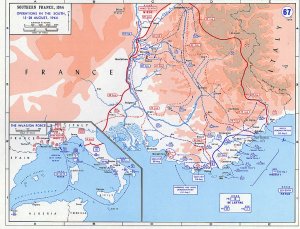
Operation Dragoon - map
https://en.wikipedia.org/wiki/Operation_Dragoon
1281 – Mongol invasion of Japan: The Mongolian fleet of Kublai Khan is destroyed by a "divine wind" for the second time in the Battle of Kōan.
The Battle of Kōan (弘安の役 Kōan no eki), also known as the Second Battle of Hakata Bay, was the second attempt by the Mongolian Yuan Dynastyto invade Japan after their failed attempt seven years earlier at the Battle of Bun'ei. In the summer of 1281 the Yuan invaded with two large armies. The Japanese defenders were aided by a major storm which sunk a sizeable portion of the Mongolian fleets. The invaders who reached the shore were repulsed shortly after landing. The Japanese called the opportune storm kamikaze ("divine wind"), a name that was used in the Second World War for pilots who carried out aerial suicide attacks.

Mooko-SamuraiShips
https://en.wikipedia.org/wiki/Battle_of_Kōan
https://en.wikipedia.org/wiki/Mongol_invasions_of_Japan
1517 – Seven Portuguese armed vessels led by Fernão Pires de Andrade meet Chinese officials at the Pearl River estuary.
Captain Fernão Pires de Andrade (also spelled as Fernão Peres de Andrade; in contemporary sources, Fernam (Fernã) Perez Dandrade) (died 1552)was a Portuguese merchant, pharmacist, and official diplomat under the explorer and Portuguese Malacca governor Afonso de Albuquerque. His encounter with Ming China in 1517—after initial contacts by Jorge Álvares and Rafael Perestrello in 1513 and 1516, respectively—marked the resumption of direct European commercial and diplomatic contact with China. (Even though there were Europeans in Medieval China, notably Marco Polo, that period of contact had been interrupted by the fall of the Yuan dynasty.) Although de Andrade's mission was initially a success that allowed a Portuguese embassy to proceed all the way to Beijing, relations were soon spoiled by culminating events that led to an extremely negative impression of the Portuguese in China. This included acts of his brother Simão that enraged the Chinese, false reports of the Portuguese being cannibals of kidnapped Chinese children and true reports of their conquest of Malacca, a loyal Ming tributary state. Normalized trade and relations between Portugal and the Ming dynasty would not resume until the late 1540s and the 1557 establishment of Portuguese rule over Macau.
Andrade was referred to as a "Folangji" (佛郎機) in Ming dynastic archives. Folangji comes from Franques or Franks, which was a generic name the Muslims called Europeans since the Crusades, and which spawned the Indian-Southeast Asian term ferengi. The Chinese adopted the convention when they first thought the Portuguese were related to those Muslim guides and interpreters during Fernão's first encounter and before Europeans directly convened with Chinese.

The Zhengde Emperor, who accepted the Portuguese embassy but died before he could finalize relations with Portugal, hence dooming the embassy as conservative factions at court in Beijing were aligned against those who conquered the Ming's loyal tributary vassal in Malacca.
https://en.wikipedia.org/wiki/Fernão_Pires_de_Andrade
1779 - French and Spanish fleets off Plymouth.
1797 - HMS Alexandrian Schooner (6), Lt. William Wood Senhouse, captured French privateer schooner Coq (6) off Martinique.
1815 - HMS Dominica Schooner (14), Lt. Richard Crawford, wrecked off Bermuda.
1944 - Operation Dragoon begins, which is the Allied invasion of Southern France. Western Naval Task Force, commanded by Vice Adm. Henry K. Hewitt, USN, lands the Allied force on the front between Toulon and Cannes.
Operation Dragoon (initially Operation Anvil) was the code name for the Allied invasion of Southern France on 15 August 1944. The operation was initially to take place in conjunction with Operation Overlord, the Allied landing in Normandy, but a lack of resources led to cancellation of the second landing. By July 1944 the landing was reconsidered, as the ports of Normandy did not have the capacity to adequately supply Allied forces. Concurrently, the French High Command pushed for a revival of the operation that would include large numbers of French troops. As a result, the operation was finally approved in July to be executed in August.
The goal of the operation was to secure vital ports on the French Mediterranean coast and increase pressure on German forces by opening a second front. After some preliminary commando operations, including the British 2nd Para's landing behind enemy lines to secure vital transport links, the US VI Corps landed on the beaches of the Côte d'Azur under the cover of a large naval task force, followed by several divisions of the French Army B. They were opposed by the scattered forces of the German Army Group G, weakened by the relocation of its divisions to other fronts and the replacement of its soldiers with third-rate Ostlegionen outfitted with obsolete equipment.

Operation Dragoon landings
Hindered by Allied air superiority and a large-scale uprising by the French Resistance, the weak German forces were swiftly defeated. The Germans withdrew to the north through the Rhône valley, to establish a stable defense line at Dijon. Allied mobile units overtook the Germans and partially blocked their route at Montélimar. The ensuing battle led to a stalemate, with neither side able to achieve a decisive breakthrough, until the Germans were finally able to complete their withdrawal and retreat from the town. While the Germans were retreating, the French captured the important ports of Marseille and Toulon, putting them into operation soon after.
The Germans were not able to hold Dijon and ordered a complete withdrawal from southern France. Army Group G retreated further north, pursued by Allied forces. The fighting ultimately came to a stop at the Vosges mountains, where Army Group G was finally able to establish a stable defense line. The Allied forces needed reorganizing and, facing stiffened German resistance, the offensive was halted on 14 September. Operation Dragoon was considered a success by the Allies. It enabled them to liberate most of southern France in only four weeks, while inflicting heavy casualties on the German forces, although many of the best German units were able to escape. The captured French ports were put into operation, allowing the Allies to solve some supply problems.

Operation Dragoon - map
https://en.wikipedia.org/wiki/Operation_Dragoon
16 August 1742 - HMS Gloucester (1711 - 50 guns) burnt near Ladrones to avoid capture by Spanish.
HMS Gloucester was a 50-gun fourth-rate ship of the line built for the Royal Navy in the 1710s. She participated in the 1701–15 War of the Spanish Succession. The ship was burned to prevent capture after she was damaged in a storm during Commodore George Anson's voyage around the world in 1742.
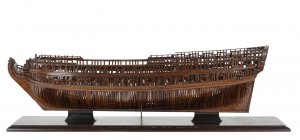
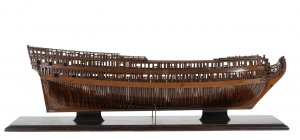
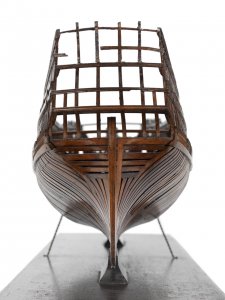
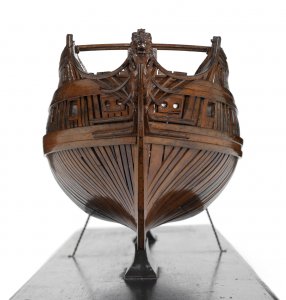
Scale: 1:48. A contemporary full hull model of a 50-gun small two-decker (circa 1715), built entirely in frame. It has been built to show the old style of construction against the new, especially around the area of the bow and stern. The wales are solid or ‘closed’ on starboard side and ‘open’ in two strips on port side. Although the framing configuration differs markedly on port and starboard sides, it has the dimensions as laid down for the 50 gun ships of the 1706 Establishment, but the closed or solid wales would suggest a later date of 1717. An important feature of this model is that it shows the hull framed up as built as opposed to the more stylized Navy Board hull framing.
Description
Gloucester had a length at the gundeck of 130 feet 8 inches (39.8 m) and 108 feet 1 inch (32.9 m) at the keel. She had a beam of 35 feet 3 inches (10.7 m) and a depth of hold of 14 feet (4.3 m). The ship's tonnage was 714 34⁄94 tons burthen. Gloucester was armed with twenty-two 18-pounder cannon on her main gundeck, twenty-two 9-pounder cannon on her upper gundeck, and four 6-pounder cannon each on the quarterdeck and forecastle. The ship had a crew of 185–280 officers and ratings.




Scale: 1:48. A contemporary full hull model of a 50-gun small two-decker (circa 1703) built plank on frame in the Navy Board style. The model is decked and equipped and mounted on an original baseboard. The monogram ‘AR’ for Queen Anne is carved into the lower stern gallery decoration. Above the open galleries is a shield inscribed ‘IL 170[?]’ which may refer to John Lock, a Master Shipwright at the Royal Dockyard, Plymouth during the early years of the 18th century. This model is unique as it is fitted with both a steering wheel and the remains of a whipstaff. If the wheel is original, it is the earliest evidence known for this fitting on an English ship. It also highly decorated with painted friezes along the bulwarks with carvings on the bow, stern galleries and wreaths around the gunports. The fourth-rate two-deckers were among the smallest warships to serve in the ‘line’ and this model represents a preliminary design for the Establishment of 1706. Measurements taken from the model would give a ship with a gun deck length of 129 feet by 34 feet in the beam and an approximate tonnage of 670 burden.
Construction and career
Gloucester, named after the eponymous port, was the fourth ship of her name to serve in the Royal Navy. She was ordered on 29 July 1710 and was built by Master Shipwright Joseph Allin to the 1706 Establishmentof dimensions at Deptford Dockyard. The ship was launched on 4 October 1711 and commissioned that same year under Captain James Carlton for service in the English Channel.
Gloucester was ordered to be dismantled to be rebuilt to the dimensions of the 1719 Establishment at Sheerness on 6 November 1724 and this was completed on 20 January 1725. The rebuilding was suspended until 22 May 1733 when the ship was reordered to the 1733 revisions; she was relaunched on 22 March 1737.
Excerpt of George Anson's voyage around the world
...........
Pacific crossing
Based on earlier accounts, Anson expected the Pacific crossing to be an easy one, taking about two months. Other voyagers had dropped south from Acapulco at 15°51'N to pick up the tradewinds that blew constantly to the west between 10° and 14°N. However, none of them had left in May by which time the band of favorable wind had moved further north as summer approached. Centurion and Gloucester wasted seven weeks in constant heat and variable light wind, or no wind at all, getting as far south as 6°40'N before giving up and heading north again. Under normal circumstances, such a delay would be a nuisance but with ships and crew in poor condition, disaster soon unfolded. The foremast of Centurion split just days out from Acapulco and Gloucester lost its mainmast in the mid-June and although improvised repairs were made, she was now much slower. Scurvy broke out first amongst the prisoners captured from the Spanish prize vessels and then at the end of June, amongst the regular crew members.
During July, Gloucester lost most of its remaining rigging and a large leak opened so that by 13 August the water inside was seven feet deep despite continuous pumping. Captain Mitchell sent a distress signal to Anson but the initial response was that leaks in Centurionwere now so serious that she too was in danger of sinking. However, when the full details emerged, Anson saw there were no alternative but to salvage whatever possible from Gloucester (not much except the captured bullion), transfer the crew and then set the ship on fire to ensure that the hulk did not drift into Spanish-held Guam. Eight to ten men were dying every day and the leak became so severe that even Anson had to take his turn at the pump. It was now a race to find land, even Guam, before the ship sunk. Tinian lies to the north and a little east of Guam and was sighted on 23 August but it took four days to find safe anchorage. Anson had a Spanish flag hoisted in the hope of gaining a better reception and a proa carrying four native people and one Spaniard came out to meet them. Fortunately they were the only ones on the island so Centurion came inshore and anchored. The sick were landed, 128 in all, a task that Anson and the crew of the proa helped but 21 died during the landing or immediately after.
The island was a lush tropical paradise with an abundance of fruit and other edible greens near the beach but also fresh water and cattle which had been brought there to provide meat for the Spanish garrison on Guam. Within just a few days, the men showed clear signs of improvement. Of particular note was the breadfruit tree. The fruit is high in starch and when boiled and then baked has a taste between potato and bread. The high praise given it by Dampier's earlier expedition and the crew of Centurion later prompted Joseph Banks to send HMS Bounty to take the plant to the Caribbean to feed plantation slaves. Having avoided drowning, the next priority was to repair Centurion. The crew shifted the cannon and later the powder barrels aft to lift the bow out of the water and the carpenters found much to replace and caulk but when the cannon and barrels were put back, the water rushed in again. The leak was apparently not going to be found and fixed without proper port facilities.
The one major short-coming of Tinian was the lack of a protected anchorage and so when a violent storm blew up at night on 18 September, the ship was blown out to sea. For the skeleton crew of 109 men and boys on board the ship and the 107 men on the island, this event was profoundly distressing. Although Lieutenant Saumarez on Centurion had lit flares and fired the signal cannon, the fury of the storm meant that nobody on shore was even aware of what had happened until the following morning. Given the state of the ship and continuing easterly winds, it was assumed by those on shore that Centurion had been blown so far west that if the crew were lucky, they might be able to make Macau where they would have to refit, or more likely, that she had sunk. In either case, they were now on their own.
......... The whole event of Anson´s voyage with the squadron composed of six warships
will be posted on 18th September, the date when the squadron sailed from Spithead overseeing a convoy of 152 ships......

Path of the Centurion under the command of George Anson
The 1706 Establishment was the first formal set of dimensions for ships of the Royal Navy. Two previous sets of dimensions had existed before, though these were only for specific shipbuilding programs running for only a given amount of time. In contrast, the 1706 Establishment was intended to be permanent.
Origins
Dimensions for ships had been established for the "Thirty Ships" building program of 1677, and while these dimensions saw use until 1695, this was merely because of the success of the 1677 ships and the lack of perceived need to change them. Dimensions were then laid down for the 1691 "Twenty-seven Ships" program to build seventeen eighty-gun and ten sixty-gun double-decked ships of the line, though the dimensions were abandoned before the program was complete, with the final four eighty-gun ships being constructed with three gun-decks.
The origins of the formalized 1706 Establishment can be traced to February 1705, when Prince George of Denmark, the Lord High Admiral at the time, ordered the Navy Board to determine a set of dimensions for second-rate ships. Though the second-rate ships appear to have been the central focus of the Establishment, the Board was also directed to consider dimensions for ships of the third- (80 and 70 guns), fourth- (60 and 50 guns), and fifth-rate ships (40 and 30 guns). Because of their rarity and power, first rates were not addressed by the Establishment and were given individual designs, whilst smaller vessels had a low enough cost to allow experimentation. The Navy Board used existing ships considered to be the best in their respective classes as the bases for these dimensions.
Implementation
The Navy Board produced sets of dimensions for ships from forty, fifty, sixty, seventy, eighty, and ninety guns (they decided against doing so for thirty-gun ships). After a last-minute adjustment created by Admiral George Churchill, the dimensions were sent out to the dockyards together with an order that they were to be strictly adhered to, and that they should apply to rebuilds as well as new ships. The implementation of the Establishment - the first of many - began an era of notorious conservatism in naval administration. Though there would be no significant technological changes until the following century, the naval architecture of the 1706 Establishment slowly became more antiquated for the early eighteenth century.
50-gun fourth-rates
General characteristics For 50-gun fourth-rates
Type: 50-gun fourth-rate ship of the line
Tons burthen: 703 68⁄94 bm
Length:
Depth of hold:14 ft 0 in (4.3 m)
Sail plan: Full-rigged ship
Complement: 280 officers and men (185 in peacetime)
Armament:
These vessels were initially armed as 54-gun ships to the 1703 Establishment of Guns (see table to right). Under the 1716 Establishment of Guns, they were re-classed as 50-gun ships with the following armament:

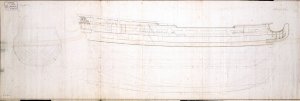
Scale: 1:48. Plan showing the body plan, sheer lines, and longitudinal half-breadth for Dartmouth (1711), a 1733 Establishment, 50-gun Fourth Rate, two-decker. The plan records that she had 'more hollow aft' than the Gloucester (1737) and Severn (1739) of the same 1733 Establishment.
Read more at http://collections.rmg.co.uk/collections/objects/81604.html#rAACkOJILDRvtEPg.99
https://en.wikipedia.org/wiki/HMS_Gloucester_(1711)
https://en.wikipedia.org/wiki/George_Anson's_voyage_around_the_world
https://en.wikipedia.org/wiki/1706_Establishment
HMS Gloucester was a 50-gun fourth-rate ship of the line built for the Royal Navy in the 1710s. She participated in the 1701–15 War of the Spanish Succession. The ship was burned to prevent capture after she was damaged in a storm during Commodore George Anson's voyage around the world in 1742.




Scale: 1:48. A contemporary full hull model of a 50-gun small two-decker (circa 1715), built entirely in frame. It has been built to show the old style of construction against the new, especially around the area of the bow and stern. The wales are solid or ‘closed’ on starboard side and ‘open’ in two strips on port side. Although the framing configuration differs markedly on port and starboard sides, it has the dimensions as laid down for the 50 gun ships of the 1706 Establishment, but the closed or solid wales would suggest a later date of 1717. An important feature of this model is that it shows the hull framed up as built as opposed to the more stylized Navy Board hull framing.
Description
Gloucester had a length at the gundeck of 130 feet 8 inches (39.8 m) and 108 feet 1 inch (32.9 m) at the keel. She had a beam of 35 feet 3 inches (10.7 m) and a depth of hold of 14 feet (4.3 m). The ship's tonnage was 714 34⁄94 tons burthen. Gloucester was armed with twenty-two 18-pounder cannon on her main gundeck, twenty-two 9-pounder cannon on her upper gundeck, and four 6-pounder cannon each on the quarterdeck and forecastle. The ship had a crew of 185–280 officers and ratings.




Scale: 1:48. A contemporary full hull model of a 50-gun small two-decker (circa 1703) built plank on frame in the Navy Board style. The model is decked and equipped and mounted on an original baseboard. The monogram ‘AR’ for Queen Anne is carved into the lower stern gallery decoration. Above the open galleries is a shield inscribed ‘IL 170[?]’ which may refer to John Lock, a Master Shipwright at the Royal Dockyard, Plymouth during the early years of the 18th century. This model is unique as it is fitted with both a steering wheel and the remains of a whipstaff. If the wheel is original, it is the earliest evidence known for this fitting on an English ship. It also highly decorated with painted friezes along the bulwarks with carvings on the bow, stern galleries and wreaths around the gunports. The fourth-rate two-deckers were among the smallest warships to serve in the ‘line’ and this model represents a preliminary design for the Establishment of 1706. Measurements taken from the model would give a ship with a gun deck length of 129 feet by 34 feet in the beam and an approximate tonnage of 670 burden.
Construction and career
Gloucester, named after the eponymous port, was the fourth ship of her name to serve in the Royal Navy. She was ordered on 29 July 1710 and was built by Master Shipwright Joseph Allin to the 1706 Establishmentof dimensions at Deptford Dockyard. The ship was launched on 4 October 1711 and commissioned that same year under Captain James Carlton for service in the English Channel.
Gloucester was ordered to be dismantled to be rebuilt to the dimensions of the 1719 Establishment at Sheerness on 6 November 1724 and this was completed on 20 January 1725. The rebuilding was suspended until 22 May 1733 when the ship was reordered to the 1733 revisions; she was relaunched on 22 March 1737.
Excerpt of George Anson's voyage around the world
...........
Pacific crossing
Based on earlier accounts, Anson expected the Pacific crossing to be an easy one, taking about two months. Other voyagers had dropped south from Acapulco at 15°51'N to pick up the tradewinds that blew constantly to the west between 10° and 14°N. However, none of them had left in May by which time the band of favorable wind had moved further north as summer approached. Centurion and Gloucester wasted seven weeks in constant heat and variable light wind, or no wind at all, getting as far south as 6°40'N before giving up and heading north again. Under normal circumstances, such a delay would be a nuisance but with ships and crew in poor condition, disaster soon unfolded. The foremast of Centurion split just days out from Acapulco and Gloucester lost its mainmast in the mid-June and although improvised repairs were made, she was now much slower. Scurvy broke out first amongst the prisoners captured from the Spanish prize vessels and then at the end of June, amongst the regular crew members.
During July, Gloucester lost most of its remaining rigging and a large leak opened so that by 13 August the water inside was seven feet deep despite continuous pumping. Captain Mitchell sent a distress signal to Anson but the initial response was that leaks in Centurionwere now so serious that she too was in danger of sinking. However, when the full details emerged, Anson saw there were no alternative but to salvage whatever possible from Gloucester (not much except the captured bullion), transfer the crew and then set the ship on fire to ensure that the hulk did not drift into Spanish-held Guam. Eight to ten men were dying every day and the leak became so severe that even Anson had to take his turn at the pump. It was now a race to find land, even Guam, before the ship sunk. Tinian lies to the north and a little east of Guam and was sighted on 23 August but it took four days to find safe anchorage. Anson had a Spanish flag hoisted in the hope of gaining a better reception and a proa carrying four native people and one Spaniard came out to meet them. Fortunately they were the only ones on the island so Centurion came inshore and anchored. The sick were landed, 128 in all, a task that Anson and the crew of the proa helped but 21 died during the landing or immediately after.
The island was a lush tropical paradise with an abundance of fruit and other edible greens near the beach but also fresh water and cattle which had been brought there to provide meat for the Spanish garrison on Guam. Within just a few days, the men showed clear signs of improvement. Of particular note was the breadfruit tree. The fruit is high in starch and when boiled and then baked has a taste between potato and bread. The high praise given it by Dampier's earlier expedition and the crew of Centurion later prompted Joseph Banks to send HMS Bounty to take the plant to the Caribbean to feed plantation slaves. Having avoided drowning, the next priority was to repair Centurion. The crew shifted the cannon and later the powder barrels aft to lift the bow out of the water and the carpenters found much to replace and caulk but when the cannon and barrels were put back, the water rushed in again. The leak was apparently not going to be found and fixed without proper port facilities.
The one major short-coming of Tinian was the lack of a protected anchorage and so when a violent storm blew up at night on 18 September, the ship was blown out to sea. For the skeleton crew of 109 men and boys on board the ship and the 107 men on the island, this event was profoundly distressing. Although Lieutenant Saumarez on Centurion had lit flares and fired the signal cannon, the fury of the storm meant that nobody on shore was even aware of what had happened until the following morning. Given the state of the ship and continuing easterly winds, it was assumed by those on shore that Centurion had been blown so far west that if the crew were lucky, they might be able to make Macau where they would have to refit, or more likely, that she had sunk. In either case, they were now on their own.
......... The whole event of Anson´s voyage with the squadron composed of six warships
- Centurion (a fourth-rate ship of 1,005 tons, 60 guns, 400 men and the flagship)
- Gloucester (853 tons, 50 guns, 300 men)
- Severn (853 tons, 50 guns, 300 men)
- Pearl (600 tons, 40 guns, 250 men)
- Wager (599 tons, 24 guns, 120 men)
- Tryal (200 tons, 8 guns, 70 men)
will be posted on 18th September, the date when the squadron sailed from Spithead overseeing a convoy of 152 ships......

Path of the Centurion under the command of George Anson
The 1706 Establishment was the first formal set of dimensions for ships of the Royal Navy. Two previous sets of dimensions had existed before, though these were only for specific shipbuilding programs running for only a given amount of time. In contrast, the 1706 Establishment was intended to be permanent.
Origins
Dimensions for ships had been established for the "Thirty Ships" building program of 1677, and while these dimensions saw use until 1695, this was merely because of the success of the 1677 ships and the lack of perceived need to change them. Dimensions were then laid down for the 1691 "Twenty-seven Ships" program to build seventeen eighty-gun and ten sixty-gun double-decked ships of the line, though the dimensions were abandoned before the program was complete, with the final four eighty-gun ships being constructed with three gun-decks.
The origins of the formalized 1706 Establishment can be traced to February 1705, when Prince George of Denmark, the Lord High Admiral at the time, ordered the Navy Board to determine a set of dimensions for second-rate ships. Though the second-rate ships appear to have been the central focus of the Establishment, the Board was also directed to consider dimensions for ships of the third- (80 and 70 guns), fourth- (60 and 50 guns), and fifth-rate ships (40 and 30 guns). Because of their rarity and power, first rates were not addressed by the Establishment and were given individual designs, whilst smaller vessels had a low enough cost to allow experimentation. The Navy Board used existing ships considered to be the best in their respective classes as the bases for these dimensions.
Implementation
The Navy Board produced sets of dimensions for ships from forty, fifty, sixty, seventy, eighty, and ninety guns (they decided against doing so for thirty-gun ships). After a last-minute adjustment created by Admiral George Churchill, the dimensions were sent out to the dockyards together with an order that they were to be strictly adhered to, and that they should apply to rebuilds as well as new ships. The implementation of the Establishment - the first of many - began an era of notorious conservatism in naval administration. Though there would be no significant technological changes until the following century, the naval architecture of the 1706 Establishment slowly became more antiquated for the early eighteenth century.
50-gun fourth-rates
General characteristics For 50-gun fourth-rates
Type: 50-gun fourth-rate ship of the line
Tons burthen: 703 68⁄94 bm
Length:
- 130 ft 0 in (39.6 m) (gundeck)
- 108 ft 0 in (32.9 m) (keel)
Depth of hold:14 ft 0 in (4.3 m)
Sail plan: Full-rigged ship
Complement: 280 officers and men (185 in peacetime)
Armament:
- 54 guns (1703 Establishment):
- Lower deck: 22 12-lb
- Upper deck: 22 6-lb
- Quarter deck: 8 6-lb
- Forecastle: 2 6-lb
These vessels were initially armed as 54-gun ships to the 1703 Establishment of Guns (see table to right). Under the 1716 Establishment of Guns, they were re-classed as 50-gun ships with the following armament:
- Lower deck: 22 18-lb
- Upper deck: 22 9-lb
- Quarter deck: 4 6-lb
- Forecastle: 2 6-lb


Scale: 1:48. Plan showing the body plan, sheer lines, and longitudinal half-breadth for Dartmouth (1711), a 1733 Establishment, 50-gun Fourth Rate, two-decker. The plan records that she had 'more hollow aft' than the Gloucester (1737) and Severn (1739) of the same 1733 Establishment.
Read more at http://collections.rmg.co.uk/collections/objects/81604.html#rAACkOJILDRvtEPg.99
https://en.wikipedia.org/wiki/HMS_Gloucester_(1711)
https://en.wikipedia.org/wiki/George_Anson's_voyage_around_the_world
https://en.wikipedia.org/wiki/1706_Establishment
16 August 1778 - HMS Isis (1774 - 50 guns) engaged french Cesar (1768 - 74 guns)
HMS Isis was a 50-gun Portland-class fourth-rate of the Royal Navy. She saw service during the American War of Independence, and the French Revolutionary and Napoleonic Wars.

Scale: 1:48. Plan showing the body plan, sheer lines, and longitudinal half-breadth proposed (and approved) for Renown (1774), and later used for Isis (1774), both 50-gun Fourth Rate two-deckers built in private yards. The plan includes a table of mast and yard dimensions. Signed by John Williams [Surveyor of the Navy, 1765-1784].
Read more at http://collections.rmg.co.uk/collections/objects/81621.html#OUP3wy2ticylcclS.99
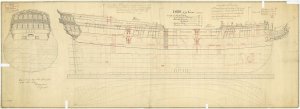
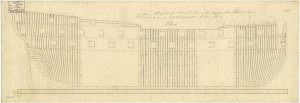
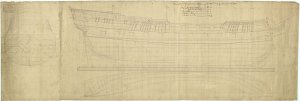
She was built in 1774 on the River Medway and commissioned under Captain Charles Douglas in 1776, at which time he sailed with a squadron for the relief of Quebec. She was involved in the Nore mutiny and fought at the Battle of Cuddalore (1783) and Battle of Camperdown (1797). The ship was also engaged at the Action of 22 August 1795 off Norway against a Dutch squadron. She then served as the flagship of Vice-Admiral Sir Andrew Mitchell during the 1799 Anglo-Russian invasion of Holland. One of her early midshipmen was Robert Faulknor the younger. She fought in the Battle of Copenhagen in 1801 under Captain James Walkerand was badly damaged by a hurricane during the Peace of Amiens on crossing the Atlantic to be Vice Admiral Gambier's flagship in Newfoundland, before going on to further service in Newfoundland, the Caribbean and the North Sea. She was broken up in September 1810.
Some Days before the Battle of Rhode Island

The French fleet arrives off Rhode Island
Some days before the Battle of Rhode Island General John Sullivan Sullivan began siege operations while awaiting the return of the French fleet, moving closer to the British lines on August 15 and opening trenches to the northeast of the fortified British line north of Newport the next day.
As the two fleets sought to regroup, individual ships encountered one another, and there were several minor naval skirmishes.
On the afternoon of the 16th the Isis 50, Captain John Raynor, fell in with the César 74, Captain Chevalier de Raymondis, which ship was flying the flag of the celebrated explorer Rear-Admiral Louis Antoine the Comte de Bougainville. After a chase over several hours the Isis seemed to be on the point of being overpowered when Captain Raynor brilliantly saved his command by crossing the Frenchman’s bows at the last minute and manoeuvring to leeward. Knowing full well that the French vessel could not open her lower deck guns in the raging sea, and perhaps being aware that her larboard guns had lumber stashed between them and had not been cleared for action, he then took the fight to his opponent. After an action of some ninety minutes another British ship of the line appeared in view, and with the Isis gaining an ascendancy the Cesar fled before the wind, her wheel shot away. Bougainville was wounded in his arm during the action and seventy other men were casualties, compared to one dead and fourteen wounded on the Isis.
The french 74 gun ship Cesar
César was a 74-gun ship built according to the standards defined by French shipbuilders in the 1740s. The design aimed to combine good manoeuvrability and armament cost effectively, so as to counter British warships.
Her hull was constructed from oak, while her masts and yards were pine. Elm, linden, poplar and walnut wood was used for the gun carriages, sculptures and carvings. 80 tons of ropes and c. 2,500 m² of sails were made of hemp, with a set of replacement sails stored in the hold. She could operate for several weeks at sea, carrying three months supply of fresh water, supplemented by six months supply of wine. Tens of tons of biscuits, flour, fresh and dried vegetables, meat and salted fish, cheese, oil, vinegar, salt, were also carried, as was live cattle, which would be slaughtered as required.
César carried twenty-eight 36-pounder guns on her lower deck, and thirty 18-pounder guns on her upper deck. In addition, sixteen 8-pounder guns were distributed on the fore and aftcastle. In total César's armament weighed around 215 tons. 6,000 cannonballs, weighing some 67 tons, were carried. There was also around 8 tons of bar, chain and grape shot. 20 tons of gunpowder was embarked, stored in the form of cartridges or in bulk in the depths of the ship. On average, each gun had 50 to 60 cannonballs.
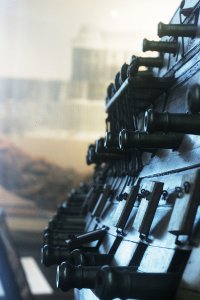
Broadside of a French 74-gun ship from 1755
American War of Independence
d'Estaing's squadron (1778-1779)
At the time of the French entry to the American War of Independence, César was under the command of Captain Joseph de Raimondis d'Allons. On 13 April 1778, César sailed from Toulon bound for America, with the 12 ships of the Comte d'Estaing's fleet. The fleet arrived at the mouth of the Delaware River, north of Baltimore, on 8 July and pursued several enemy ships. On 8 August, it forced the straits at New York and entered the mouth of the Connecticut River, where the British forces were anchored. The British burnt seven of their ships and their stores. On 11 August 1778, the César was separated from the squadron by a violent storm at the time when they were about to engage in a battle with the forces of Richard Howe. On 16 August 1778, César battled HMS Iris and then went to shelter in Boston, where she was joined by the other French ships.
In December 1778, after d'Estaing's squadron had transferred to the West Indies, the César took part in the French defeat at the Battle of St. Lucia. On 6 July 1779 César was part of the rear squadron in the hard-fought battle of Grenada against the forces of John Byron. After Estaing's failure to support the Siege of Savannah in October 1779, the César returned to France with the other ships that had arrived on America in 1778 in order to be refitted and to recruit new crew.

The end of the César, by François Aimé Louis Dumoulin.
De Grasse's fleet (1781-1782)
In 1781, the César left for the West Indies under the command of Charles Régis de Coriolis d'Espinouse in the fleet of the Comte de Grasse. On 28 April she was present at the Battle of Fort Royal, attempting to raise the blockade of Martinique. On 24 May César was part of the squadron which covered the French Invasion of Tobago. On 5 September 1781 César was present at the decisive battle of the Chesapeake, which completed the encirclement of the British forces at Yorktown.
In 1782, still with De Grasse's fleet, César sailed to the West Indies and in January took part in the Battle of Saint Kitts. César was then at the Battle of the Saintes on 12 April 1782, during which she was totally dismasted and then captured by HMS Centaur. In the night after the battle, a fire broke out in the magazine, causing it to explode. The César was destroyed, killing 400 French sailors and 50 British members of the prize crew. The César was one of the twenty ships lost by the French Navy during the American War of Independence.
https://en.wikipedia.org/wiki/HMS_Isis_(1774)
https://en.wikipedia.org/wiki/French_ship_César_(1768)
https://morethannelson.com/relief-rhode-island-august-1778/
HMS Isis was a 50-gun Portland-class fourth-rate of the Royal Navy. She saw service during the American War of Independence, and the French Revolutionary and Napoleonic Wars.

Scale: 1:48. Plan showing the body plan, sheer lines, and longitudinal half-breadth proposed (and approved) for Renown (1774), and later used for Isis (1774), both 50-gun Fourth Rate two-deckers built in private yards. The plan includes a table of mast and yard dimensions. Signed by John Williams [Surveyor of the Navy, 1765-1784].
Read more at http://collections.rmg.co.uk/collections/objects/81621.html#OUP3wy2ticylcclS.99



She was built in 1774 on the River Medway and commissioned under Captain Charles Douglas in 1776, at which time he sailed with a squadron for the relief of Quebec. She was involved in the Nore mutiny and fought at the Battle of Cuddalore (1783) and Battle of Camperdown (1797). The ship was also engaged at the Action of 22 August 1795 off Norway against a Dutch squadron. She then served as the flagship of Vice-Admiral Sir Andrew Mitchell during the 1799 Anglo-Russian invasion of Holland. One of her early midshipmen was Robert Faulknor the younger. She fought in the Battle of Copenhagen in 1801 under Captain James Walkerand was badly damaged by a hurricane during the Peace of Amiens on crossing the Atlantic to be Vice Admiral Gambier's flagship in Newfoundland, before going on to further service in Newfoundland, the Caribbean and the North Sea. She was broken up in September 1810.
Some Days before the Battle of Rhode Island

The French fleet arrives off Rhode Island
Some days before the Battle of Rhode Island General John Sullivan Sullivan began siege operations while awaiting the return of the French fleet, moving closer to the British lines on August 15 and opening trenches to the northeast of the fortified British line north of Newport the next day.
As the two fleets sought to regroup, individual ships encountered one another, and there were several minor naval skirmishes.
On the afternoon of the 16th the Isis 50, Captain John Raynor, fell in with the César 74, Captain Chevalier de Raymondis, which ship was flying the flag of the celebrated explorer Rear-Admiral Louis Antoine the Comte de Bougainville. After a chase over several hours the Isis seemed to be on the point of being overpowered when Captain Raynor brilliantly saved his command by crossing the Frenchman’s bows at the last minute and manoeuvring to leeward. Knowing full well that the French vessel could not open her lower deck guns in the raging sea, and perhaps being aware that her larboard guns had lumber stashed between them and had not been cleared for action, he then took the fight to his opponent. After an action of some ninety minutes another British ship of the line appeared in view, and with the Isis gaining an ascendancy the Cesar fled before the wind, her wheel shot away. Bougainville was wounded in his arm during the action and seventy other men were casualties, compared to one dead and fourteen wounded on the Isis.
The french 74 gun ship Cesar
César was a 74-gun ship built according to the standards defined by French shipbuilders in the 1740s. The design aimed to combine good manoeuvrability and armament cost effectively, so as to counter British warships.
Her hull was constructed from oak, while her masts and yards were pine. Elm, linden, poplar and walnut wood was used for the gun carriages, sculptures and carvings. 80 tons of ropes and c. 2,500 m² of sails were made of hemp, with a set of replacement sails stored in the hold. She could operate for several weeks at sea, carrying three months supply of fresh water, supplemented by six months supply of wine. Tens of tons of biscuits, flour, fresh and dried vegetables, meat and salted fish, cheese, oil, vinegar, salt, were also carried, as was live cattle, which would be slaughtered as required.
César carried twenty-eight 36-pounder guns on her lower deck, and thirty 18-pounder guns on her upper deck. In addition, sixteen 8-pounder guns were distributed on the fore and aftcastle. In total César's armament weighed around 215 tons. 6,000 cannonballs, weighing some 67 tons, were carried. There was also around 8 tons of bar, chain and grape shot. 20 tons of gunpowder was embarked, stored in the form of cartridges or in bulk in the depths of the ship. On average, each gun had 50 to 60 cannonballs.

Broadside of a French 74-gun ship from 1755
American War of Independence
d'Estaing's squadron (1778-1779)
At the time of the French entry to the American War of Independence, César was under the command of Captain Joseph de Raimondis d'Allons. On 13 April 1778, César sailed from Toulon bound for America, with the 12 ships of the Comte d'Estaing's fleet. The fleet arrived at the mouth of the Delaware River, north of Baltimore, on 8 July and pursued several enemy ships. On 8 August, it forced the straits at New York and entered the mouth of the Connecticut River, where the British forces were anchored. The British burnt seven of their ships and their stores. On 11 August 1778, the César was separated from the squadron by a violent storm at the time when they were about to engage in a battle with the forces of Richard Howe. On 16 August 1778, César battled HMS Iris and then went to shelter in Boston, where she was joined by the other French ships.
In December 1778, after d'Estaing's squadron had transferred to the West Indies, the César took part in the French defeat at the Battle of St. Lucia. On 6 July 1779 César was part of the rear squadron in the hard-fought battle of Grenada against the forces of John Byron. After Estaing's failure to support the Siege of Savannah in October 1779, the César returned to France with the other ships that had arrived on America in 1778 in order to be refitted and to recruit new crew.

The end of the César, by François Aimé Louis Dumoulin.
De Grasse's fleet (1781-1782)
In 1781, the César left for the West Indies under the command of Charles Régis de Coriolis d'Espinouse in the fleet of the Comte de Grasse. On 28 April she was present at the Battle of Fort Royal, attempting to raise the blockade of Martinique. On 24 May César was part of the squadron which covered the French Invasion of Tobago. On 5 September 1781 César was present at the decisive battle of the Chesapeake, which completed the encirclement of the British forces at Yorktown.
In 1782, still with De Grasse's fleet, César sailed to the West Indies and in January took part in the Battle of Saint Kitts. César was then at the Battle of the Saintes on 12 April 1782, during which she was totally dismasted and then captured by HMS Centaur. In the night after the battle, a fire broke out in the magazine, causing it to explode. The César was destroyed, killing 400 French sailors and 50 British members of the prize crew. The César was one of the twenty ships lost by the French Navy during the American War of Independence.
https://en.wikipedia.org/wiki/HMS_Isis_(1774)
https://en.wikipedia.org/wiki/French_ship_César_(1768)
https://morethannelson.com/relief-rhode-island-august-1778/
16 August 1779 - HMS Ardent (1764 - 64 guns), Cptn. Phillip Boteler, captured by Franco-Spanish fleet in the Channel.
HMS Ardent was a 64-gun Ardent-class third-rate ship of the line of the Royal Navy. She was built by contract by Hugh Blaydes at Hull according to a design by Sir Thomas Slade, and launched on 13 August 1764 as the first ship of the Ardent-class. She had a somewhat turbulent career, being captured by the French in 1779, and then re-captured by Britain in 1782.

Scale: 1:48. Plan showing the body plan, sheer lines with quarter gallery decoration, and longitudinal half-breadth proposed (and approved) for building Ardent (1764) at Hull, and later for Raisonnable (1768), both 64-gun Third Rate, two-deckers. Signed by Thomas Slade [Surveyor of the Navy, 1755-1771], and John Clevland [Secretary to the Admiralty].
Read more at http://collections.rmg.co.uk/collections/objects/81292.html#1DGQdGumIRGQkFmj.99


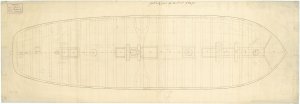
The Ardent was first commissioned in October 1774 under Captain Sir George Douglas. In 1778, under the command of Captain George Keppel, she was with Admiral Lord Howe's squadron off New York, defending the town from the larger French fleet under the command of Admiral d'Estaing. The two forces engaged in an action off Rhode Island on 11 August, though both fleets were scattered by a storm over the following two days. She returned home to Portsmouth and was paid off in January 1779.
June 1779 saw Ardent recommissioned under the command of Captain Phillip Boteler, sailing from Plymouth in August to join Sir Charles Hardy in the Channel. According to the ship's logs, as many as 4/5 of the crew were landmen, and neither Boteler nor the captain of the Marlborough, in whose company Ardent was sailing, were aware that a French fleet had put to sea. Ardent encountered a fleet two days after sailing, and after receiving the correct replies to the private signal, ran down to meet them. The fleet however was a Franco-Spanish fleet, somehow in possession of the Royal Navy signal code book, thus permitting the correct response to Ardent's signals.
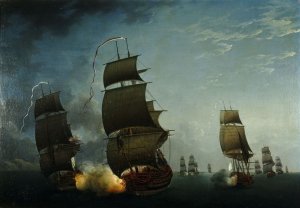
Capture of HMS Ardent by the frigates Junon and Gentille
With Ardent within range, the French frigate Junon fired two broadsides before raising her colours. Three further frigates, and the Spanish ship of the line Princesa joined the action shortly afterward. In response, Ardent offered sporadic and inaccurate return fire before striking her colours to the vastly superior enemy force. At his subsequent court martial Captain Boteler blamed his failure to return fire on an inadequate supply of gunpowder for Ardent′s cannons, a statement strongly denied by the ship's gunner Archibald Macintyre who presented evidence there was enough powder for fifty minutes of vigorous engagement. The court martial rejected Boteler's claims, finding instead that the inexperience of the crew was the principal cause of Ardent′s failure to respond to the attack. Boteler was dismissed from the Navy for his failure to adequately defend his ship.
Little is known of Ardent's career in the French Navy; however the British re-captured her on 14 April 1782 following the Battle of the Saintes, and recommissioned her that month under Captain Richard Lucas. On 28 August 1783 the ship was renamed Tiger. She was sold out of the service in June 1784.
Ships of the Ardent class
Builder: Blades, Hull
Launched: 13 August 1764
Fate: Sold out of the service, 1784
Builder: Chatham Dockyard
Launched: 10 December 1768
Fate: Broken up, 1815
Launched: 10 April 1781
Fate: Wrecked, 1809
Builder: Perry, Blackwall Yard
Launched: 5 June 1780
Fate: Broken up, 1816
Builder: Raymond, Northam
Launched: 27 December 1784
Fate: Broken up, 1814
Builder: Adams, Bucklers Hard
Launched: July 1784
Fate: Broken up, 1816
Builder: Hilhouse, Bristol
Launched: 28 September 1785
Fate: Wrecked, 1799
https://en.wikipedia.org/wiki/HMS_Ardent_(1764)
https://en.wikipedia.org/wiki/Ardent-class_ship_of_the_line
http://collections.rmg.co.uk/collec...el-292340;browseBy=vessel;vesselFacetLetter=A
https://en.wikipedia.org/wiki/French_frigate_Junon_(1778)
https://en.wikipedia.org/wiki/Spanish_ship_Princesa_(1750)
HMS Ardent was a 64-gun Ardent-class third-rate ship of the line of the Royal Navy. She was built by contract by Hugh Blaydes at Hull according to a design by Sir Thomas Slade, and launched on 13 August 1764 as the first ship of the Ardent-class. She had a somewhat turbulent career, being captured by the French in 1779, and then re-captured by Britain in 1782.

Scale: 1:48. Plan showing the body plan, sheer lines with quarter gallery decoration, and longitudinal half-breadth proposed (and approved) for building Ardent (1764) at Hull, and later for Raisonnable (1768), both 64-gun Third Rate, two-deckers. Signed by Thomas Slade [Surveyor of the Navy, 1755-1771], and John Clevland [Secretary to the Admiralty].
Read more at http://collections.rmg.co.uk/collections/objects/81292.html#1DGQdGumIRGQkFmj.99



The Ardent was first commissioned in October 1774 under Captain Sir George Douglas. In 1778, under the command of Captain George Keppel, she was with Admiral Lord Howe's squadron off New York, defending the town from the larger French fleet under the command of Admiral d'Estaing. The two forces engaged in an action off Rhode Island on 11 August, though both fleets were scattered by a storm over the following two days. She returned home to Portsmouth and was paid off in January 1779.
June 1779 saw Ardent recommissioned under the command of Captain Phillip Boteler, sailing from Plymouth in August to join Sir Charles Hardy in the Channel. According to the ship's logs, as many as 4/5 of the crew were landmen, and neither Boteler nor the captain of the Marlborough, in whose company Ardent was sailing, were aware that a French fleet had put to sea. Ardent encountered a fleet two days after sailing, and after receiving the correct replies to the private signal, ran down to meet them. The fleet however was a Franco-Spanish fleet, somehow in possession of the Royal Navy signal code book, thus permitting the correct response to Ardent's signals.

Capture of HMS Ardent by the frigates Junon and Gentille
With Ardent within range, the French frigate Junon fired two broadsides before raising her colours. Three further frigates, and the Spanish ship of the line Princesa joined the action shortly afterward. In response, Ardent offered sporadic and inaccurate return fire before striking her colours to the vastly superior enemy force. At his subsequent court martial Captain Boteler blamed his failure to return fire on an inadequate supply of gunpowder for Ardent′s cannons, a statement strongly denied by the ship's gunner Archibald Macintyre who presented evidence there was enough powder for fifty minutes of vigorous engagement. The court martial rejected Boteler's claims, finding instead that the inexperience of the crew was the principal cause of Ardent′s failure to respond to the attack. Boteler was dismissed from the Navy for his failure to adequately defend his ship.
Little is known of Ardent's career in the French Navy; however the British re-captured her on 14 April 1782 following the Battle of the Saintes, and recommissioned her that month under Captain Richard Lucas. On 28 August 1783 the ship was renamed Tiger. She was sold out of the service in June 1784.
Ships of the Ardent class
Builder: Blades, Hull
Launched: 13 August 1764
Fate: Sold out of the service, 1784
Builder: Chatham Dockyard
Launched: 10 December 1768
Fate: Broken up, 1815
- HMS Agamemnon (see here also the beautiful kit from Jotika in scale 1:64 - Kit Review available in SOS)
Launched: 10 April 1781
Fate: Wrecked, 1809
Builder: Perry, Blackwall Yard
Launched: 5 June 1780
Fate: Broken up, 1816
Builder: Raymond, Northam
Launched: 27 December 1784
Fate: Broken up, 1814
Builder: Adams, Bucklers Hard
Launched: July 1784
Fate: Broken up, 1816
Builder: Hilhouse, Bristol
Launched: 28 September 1785
Fate: Wrecked, 1799
https://en.wikipedia.org/wiki/HMS_Ardent_(1764)
https://en.wikipedia.org/wiki/Ardent-class_ship_of_the_line
http://collections.rmg.co.uk/collec...el-292340;browseBy=vessel;vesselFacetLetter=A
https://en.wikipedia.org/wiki/French_frigate_Junon_(1778)
https://en.wikipedia.org/wiki/Spanish_ship_Princesa_(1750)
16 August 1801 - Horatio Nelson failed in his attack on Boulogne
The raid on Boulogne in 1801 was a failed attempt by elements of the Royal Navy led by Vice Admiral Lord Horatio Nelson to destroy a flotilla of French vessels anchored in the port of Boulogne, a fleet which was thought to be used for the invasion of England, during the French Revolutionary Wars. At dawn on 4 August, Nelson ordered five bomb vessels to move forward and open fire against the French line. Despite the inferior gunpowder of French artillery and the high number of shots fired by the bomb vessels, the British sustained more casualties and withdrew. The night of 16 August Nelson returned and tried to bring off the flotilla, attacking with seventy boats and nearly two thousand men organized into four divisions, but the attack was successfully repelled by the defenders, led by Admiral Latouche Tréville.

Nelson fails against the flotilla at Boulogne-sur-mer, near Boulogne - 15th of August 1801, by Louis-Philippe Crépin (1772 Paris – 1851)
Background
In February 1801 the continental war against the French Republic ceased by a treaty of peace concluded at Lunéville on 9 February between that country and the Austrian Empire, who accepted the French control up to the Rhine and the French client republics in Italy and the Netherlands. In March the British government made the first peace proposal to the French, but the collapse of the League of the North due the death of the tsar Paul I and the French reversals in Portugal and Egypt caused an improvement of the British strategic situation, and the peace negotiations dragged on through the spring.
Because of this, the unemployed French armies gathered at the Channel ports, and the preparation for an invasion began. On 12 July Bonaparte issued an order for the assemblage at Boulogne of nine divisions of gun-vessels and of the same number of battalions of troops, besides several detachments of artillery to serve the guns on board the flotilla. Rear-Admiral Latouche Tréville was appointed the commander in chief and was given directions to exercise the troops in ship-working, in firing the guns, in boarding and in getting in and out of the vessels. Concentrations of troops and flat-bottomed boats were also reported at the ports of Le Havre and Dunkirk. These preparations were exaggerated by the French journals, including the official French government newspaper, Le Moniteur, which published the first consul’s threat of invasion on 21 June. In fact, Bonaparte’s only objective was to intimidate the British government into accepting disadvantageous peace terms.
Although the British intelligence doubted that the French invasion would take place, the counter-invasion orders of 1797 were reintroduced. The number of sloops and gun brigs in the Channel Islands were increased. In the southern counties cattle were driven inland, and main roads were blocked. Nelson, who recently returned from the Baltic, received detailed instructions of the admiralty to be employed in the defence of the mouths of the Thames and Medway, and all parts of the coast of Sussex, Essex and Kent. He was also required to block up or destroy, if practicable, the French vessels and craft in the ports wherein they may be assembled. All the intelligence pointed to Boulogne as the main port in which the French invasion craft were gathering, so Lord Nelson set course to there.
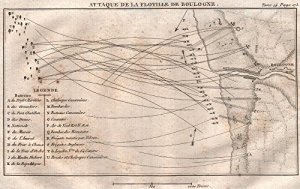
'Attaque de la Flotille de Boulogne' /ENGRAVER: Panckoucke, Charles Louis Fleury
First attack
Nelson, with the 18-pounder 32-gun frigate HMS Medusa under Captain John Gore as flagship, arrived at the port of Boulogne the evening of 3 August. He placed his 28 gunboats and five bomb vessels at a distance of 3 km from the port, out of range of the French army land batteries above and beside Boulogne. At 5 am the next day the division of bomb vessels was placed ahead of the rest of the squadron and the attack began, although Nelson was aware that a long-distance naval bombardment was unlikely to be decisive.
The 5 bomb vessels bombarded the French defensive line moored in front of Boulogne for 16 hours, firing between 750 and 848 shots. The French forces were unable to respond to the British fire because of the poor state of their gunpowder. As a result of this, Latouche Tréville considered moving towards the British ships to board them, but finally refused this plan because of the poor construction of his gunboats.
Finally, Nelson, seeing that the bombardment caused only minor damage, returned to England. He reported three flats and a brig sunk and the driving of several others on shore; however, Latouche Tréville only admitted two gunboats sunk, one of which was later recovered. The British lost 4 or 5 men and two gunboats, one of which exploded when its mortar burst.
After this first attack Nelson was conscious that the French flotilla did not pose any serious risk.
Second attack
For his second attack, Nelson was unable to do a bombardment because the first attack and the preparations for the second along the Kent coast had alerted the French. Admiral Latouche-Tréville had reinforced his vessels with three battalions of soldiers from the brigades 47th, 56th and 108th, as well as nets, to prevent boarding. Nelson decided to launch a surprise night attack, as he had previously in the Battle of Santa Cruz de Tenerife (1797). For this purpose he organized four divisions of boats under the respective commands of Captains Philip Somerville, Edward Thornborough Parker, Isaac Cotgrave, and Robert Jones, and a division of mortar-boats, under Captain John Conn, to attempt to bring off the French flotilla.
At about 11 h. 30 m. pm the four divisions, who had crossed the Channel tied together, put off from the Medusa in good order, but they lost touch with each other because of the darkness of the moonless night. The tidal current and the half-tide separated them further, causing Robert Jones’s division to be swept past the French vessels and saw no action. The other three divisions attacked different parts of the French line separately and at different times.
The first division, under Captain Somerville, approaching the shore, was swept away by the current to the eastward of Boulogne bay. Somerville, finding impossible an attack on the French vessels in the order prescribed, ordered the boats to cast each other off to move more easily. Shortly before the dawn of the following day, some of his leading boats attacked a French brig near Boulogne pier and tried to carry it away, but she was moored with chains that could not be cut. The French heavy fire of musketry and grapeshot from the shore defenses, three luggers, and a second brig located very close to the first, forced Somerville’s forces to withdraw leaving behind his prize.
https://en.wikipedia.org/wiki/Raids_on_Boulogne
The raid on Boulogne in 1801 was a failed attempt by elements of the Royal Navy led by Vice Admiral Lord Horatio Nelson to destroy a flotilla of French vessels anchored in the port of Boulogne, a fleet which was thought to be used for the invasion of England, during the French Revolutionary Wars. At dawn on 4 August, Nelson ordered five bomb vessels to move forward and open fire against the French line. Despite the inferior gunpowder of French artillery and the high number of shots fired by the bomb vessels, the British sustained more casualties and withdrew. The night of 16 August Nelson returned and tried to bring off the flotilla, attacking with seventy boats and nearly two thousand men organized into four divisions, but the attack was successfully repelled by the defenders, led by Admiral Latouche Tréville.

Nelson fails against the flotilla at Boulogne-sur-mer, near Boulogne - 15th of August 1801, by Louis-Philippe Crépin (1772 Paris – 1851)
Background
In February 1801 the continental war against the French Republic ceased by a treaty of peace concluded at Lunéville on 9 February between that country and the Austrian Empire, who accepted the French control up to the Rhine and the French client republics in Italy and the Netherlands. In March the British government made the first peace proposal to the French, but the collapse of the League of the North due the death of the tsar Paul I and the French reversals in Portugal and Egypt caused an improvement of the British strategic situation, and the peace negotiations dragged on through the spring.
Because of this, the unemployed French armies gathered at the Channel ports, and the preparation for an invasion began. On 12 July Bonaparte issued an order for the assemblage at Boulogne of nine divisions of gun-vessels and of the same number of battalions of troops, besides several detachments of artillery to serve the guns on board the flotilla. Rear-Admiral Latouche Tréville was appointed the commander in chief and was given directions to exercise the troops in ship-working, in firing the guns, in boarding and in getting in and out of the vessels. Concentrations of troops and flat-bottomed boats were also reported at the ports of Le Havre and Dunkirk. These preparations were exaggerated by the French journals, including the official French government newspaper, Le Moniteur, which published the first consul’s threat of invasion on 21 June. In fact, Bonaparte’s only objective was to intimidate the British government into accepting disadvantageous peace terms.
Although the British intelligence doubted that the French invasion would take place, the counter-invasion orders of 1797 were reintroduced. The number of sloops and gun brigs in the Channel Islands were increased. In the southern counties cattle were driven inland, and main roads were blocked. Nelson, who recently returned from the Baltic, received detailed instructions of the admiralty to be employed in the defence of the mouths of the Thames and Medway, and all parts of the coast of Sussex, Essex and Kent. He was also required to block up or destroy, if practicable, the French vessels and craft in the ports wherein they may be assembled. All the intelligence pointed to Boulogne as the main port in which the French invasion craft were gathering, so Lord Nelson set course to there.

'Attaque de la Flotille de Boulogne' /ENGRAVER: Panckoucke, Charles Louis Fleury
First attack
Nelson, with the 18-pounder 32-gun frigate HMS Medusa under Captain John Gore as flagship, arrived at the port of Boulogne the evening of 3 August. He placed his 28 gunboats and five bomb vessels at a distance of 3 km from the port, out of range of the French army land batteries above and beside Boulogne. At 5 am the next day the division of bomb vessels was placed ahead of the rest of the squadron and the attack began, although Nelson was aware that a long-distance naval bombardment was unlikely to be decisive.
The 5 bomb vessels bombarded the French defensive line moored in front of Boulogne for 16 hours, firing between 750 and 848 shots. The French forces were unable to respond to the British fire because of the poor state of their gunpowder. As a result of this, Latouche Tréville considered moving towards the British ships to board them, but finally refused this plan because of the poor construction of his gunboats.
Finally, Nelson, seeing that the bombardment caused only minor damage, returned to England. He reported three flats and a brig sunk and the driving of several others on shore; however, Latouche Tréville only admitted two gunboats sunk, one of which was later recovered. The British lost 4 or 5 men and two gunboats, one of which exploded when its mortar burst.
After this first attack Nelson was conscious that the French flotilla did not pose any serious risk.
Second attack
For his second attack, Nelson was unable to do a bombardment because the first attack and the preparations for the second along the Kent coast had alerted the French. Admiral Latouche-Tréville had reinforced his vessels with three battalions of soldiers from the brigades 47th, 56th and 108th, as well as nets, to prevent boarding. Nelson decided to launch a surprise night attack, as he had previously in the Battle of Santa Cruz de Tenerife (1797). For this purpose he organized four divisions of boats under the respective commands of Captains Philip Somerville, Edward Thornborough Parker, Isaac Cotgrave, and Robert Jones, and a division of mortar-boats, under Captain John Conn, to attempt to bring off the French flotilla.
At about 11 h. 30 m. pm the four divisions, who had crossed the Channel tied together, put off from the Medusa in good order, but they lost touch with each other because of the darkness of the moonless night. The tidal current and the half-tide separated them further, causing Robert Jones’s division to be swept past the French vessels and saw no action. The other three divisions attacked different parts of the French line separately and at different times.
The first division, under Captain Somerville, approaching the shore, was swept away by the current to the eastward of Boulogne bay. Somerville, finding impossible an attack on the French vessels in the order prescribed, ordered the boats to cast each other off to move more easily. Shortly before the dawn of the following day, some of his leading boats attacked a French brig near Boulogne pier and tried to carry it away, but she was moored with chains that could not be cut. The French heavy fire of musketry and grapeshot from the shore defenses, three luggers, and a second brig located very close to the first, forced Somerville’s forces to withdraw leaving behind his prize.
https://en.wikipedia.org/wiki/Raids_on_Boulogne
16 August 1807 - Beginning of the Second Battle of Copenhagen
The Second Battle of Copenhagen (or the Bombardment of Copenhagen) (16 August – 5 September 1807) was a British bombardment of the Danish capital, Copenhagen in order to capture or destroy the Dano-Norwegian fleet, during the Napoleonic Wars. The incident led to the outbreak of the Anglo-Russian War of 1807, which ended with the Treaty of Örebro in 1812.
Britain's first response to Napoleon's Continental system was to launch a major naval attack on the weakest link in Napoleon's coalition, Denmark. Although ostensibly neutral, Denmark was under heavy French and Russian pressure to pledge its fleet to Napoleon. In September 1807, the Royal Navy bombarded Copenhagen, seizing the Danish fleet, and assured use of the sea lanes in the North Sea and Baltic Sea for the British merchant fleet. A consequence of the attack was that Denmark did join the war on the side of France, but without a fleet it had little to offer.

The attack gave rise to the term to Copenhagenize.
Background
Despite the defeat and loss of many ships in the first Battle of Copenhagen in 1801, Denmark-Norway, possessing Jutland, Norway, Greenland, Schleswig-Holstein, Iceland, and several smaller territories, still maintained a considerable navy. The majority of the Danish army, under the Crown Prince, was at this time defending the southern border against possible attack from the French.
There was concern in Britain that Napoleon might try to force Denmark to close the Baltic Sea to British ships, perhaps by marching French troops into Zealand. The British believed that access to the Baltic was "vitally important to Britain" for trade as well as a major source of necessary raw materials for building and maintaining warships, and that it gave the Royal Navy access to help Britain's allies Sweden and (before Tilsit) Russia against France. The British thought that after Prussia had been defeated in December 1806, Denmark's independence looked increasingly under threat from France. George Canning's predecessor as Foreign Secretary, Lord Howick, had tried unsuccessfully to persuade Denmark into a secret alliance with Britain and Sweden.
The reports of French diplomats and merchants in northern Europe made the British government uneasy, and by mid-July the British believed that the French intended to invade Holstein in order to use Denmark against Britain. Some reports suggested that the Danes had secretly agreed to this. The Cabinet decided to act, and on 14 July Lord Mulgrave obtained from the King permission to send a naval force of 21 to 22 ships to the Kattegat for surveillance of the Danish navy in order to pursue "prompt and vigorous operations" if that seemed necessary. The Cabinet decided on 18 July to send Francis Jackson on a secret mission to Copenhagen to persuade Denmark to give its fleet to Britain. That same day, the Admiralty issued an order for more than 50 ships to sail for "particular service" under Admiral James Gambier. On 19 July, Lord Castlereagh, the Secretary of State for War and the Colonies, ordered General Lord Cathcart at Stralsund to go with his troops to the Sound where they would get reinforcements.
During the night of 21/22 July, Canning received intelligence from Tilsit that Napoleon had tried to persuade Alexander I of Russia to form a maritime league with Denmark and Portugal against Britain. Spencer Perceval, the Chancellor of the Exchequer, wrote a memorandum setting out the government's case for sending forces to Copenhagen: "The intelligence from so many and such various sources" that Napoleon's intent was to force Denmark into war against Britain could not be doubted.
The British assembled a force of 25,000 troops, and the vanguard sailed on 30 July; Jackson set out the next day. Canning offered Denmark a treaty of alliance and mutual defence, with a convention signed for the return of the fleet after the war, the protection of 21 British warships and a subsidy for how many soldiers Denmark kept standing. On 31 July, Napoleon ordered Talleyrand to tell Denmark to prepare for war against Britain or else Jean-Baptiste Bernadotte would invade Holstein. Neither Talleyrand nor Jackson persuaded the Danes to end their neutrality, so Jackson went back to the British fleet assembled in the Sound on 15 August. The British published a proclamation demanding the deposit of the Danish fleet; the Danes responded with "what amounted to a declaration of war".
Bombardment
The Danish forces in the city amounted to 5,000 regular troops and a similar number of militia. Most of the civilian inhabitants of Copenhagen were evacuated in the few days before Copenhagen was completely invested.
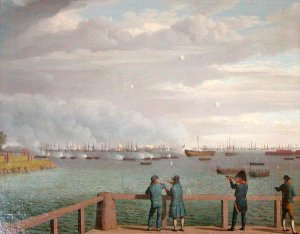
Contemporary Danish painting of the battle seen from land.
On 26 August, General Wellesley was detached with his reserve and two light brigades of British artillery, as well as one battalion, eight squadrons and one troop of horse artillery from the King's German Legion (KGL) to disperse a force which had been sent to relieve the beleaguered city. On 29 August, at the rivulet of Køge, this significant British force swiftly overpowered the Danish troops, which amounted to only three or four regular battalions and some cavalry.
The Danes rejected British demands, so the British fleet under Admiral Gambier bombarded the city from 2 to 5 September 1807. In addition to the military casualties, the British bombardment of Copenhagen killed some 195 civilians and injured 768. The bombardment included 300 Congreve Rockets, which caused fires. Due to the civilian evacuation, the normal firefighting arrangements were ineffective; over a thousand buildings were burned.
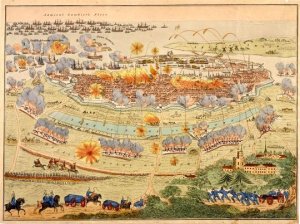
The British Bombardment of Copenhagen 1807
On 5 September, the Danes sued for peace, and the capitulation was signed on 7 September. Denmark agreed to surrender its navy and its naval stores. In return, the British undertook to leave Copenhagen within six weeks.
Peymann had been under orders from the Crown Prince to burn the Danish fleet, which he failed to do, though the reason for his failure is unknown.
Thus, on 7 September 1807 Peymann surrendered the fleet (eighteen ships of the line, eleven frigates, two smaller ships, two ship-sloops, seven brig-sloops, two brigs, one schooner and twenty-six gunboats). In addition, the British broke up or destroyed three 74-gun ships-of-the-line on the stocks, along with two of the ships-of-the-fleet and two elderly frigates. After her capture, one ex-Danish ship-of-the-line, Neptunos, ran aground and was burnt on or near the island of Hven. Then, when a storm arose in the Kattegat, the British destroyed or abandoned twenty-three of the captured gunboats. The British added the fifteen captured ships-of-the-line that reached Britain to the British Navy but only four — Christian VII 80, Dannemark 74, Norge 74 and Princess Carolina 74 — saw subsequent active service.

British soldiers destroyed ships waiting for repair
On 21 October 1807, the British fleet left Copenhagen for the United Kingdom. However, the war continued until 1814, when the Treaty of Kiel was signed.
Ships involved:
The following ships sailed with Gambier from England on 26 July 1807:
Prince of Wales 98, Pompee 74, Centaur 74, Ganges 74, Alfred 74, Brunswick 74, Captain 74, Goliath 74, Hercule 74, Maida 74, Orion 74, Resolution 74, Spencer 74, Vanguard 74, Dictator 64, Nassau 64, Ruby 64, Surveillante 38, Sibylle 38, Franchise 36, Nymphe 36,
The following vessels joined later off Helsingør:
Superb 74, Minotaur 74, Valiant 74, Inflexible 64, Leyden 64, Defence 74, Mars 74, Agamemnon 64, Africaine 32
In addition, there were another three dozen smaller frigates, sloops, bomb vessels, gun-brigs and schooners and a very large number of merchant or requisitioned ships carrying troops or supplies.
Ships surrendered
Ships-of-the-Line
http://en.wikipedia.org/wiki/Battle_of_Copenhagen_(1807)
https://en.wikipedia.org/wiki/Copenhagenization_(naval)
The Second Battle of Copenhagen (or the Bombardment of Copenhagen) (16 August – 5 September 1807) was a British bombardment of the Danish capital, Copenhagen in order to capture or destroy the Dano-Norwegian fleet, during the Napoleonic Wars. The incident led to the outbreak of the Anglo-Russian War of 1807, which ended with the Treaty of Örebro in 1812.
Britain's first response to Napoleon's Continental system was to launch a major naval attack on the weakest link in Napoleon's coalition, Denmark. Although ostensibly neutral, Denmark was under heavy French and Russian pressure to pledge its fleet to Napoleon. In September 1807, the Royal Navy bombarded Copenhagen, seizing the Danish fleet, and assured use of the sea lanes in the North Sea and Baltic Sea for the British merchant fleet. A consequence of the attack was that Denmark did join the war on the side of France, but without a fleet it had little to offer.

The attack gave rise to the term to Copenhagenize.
Background
Despite the defeat and loss of many ships in the first Battle of Copenhagen in 1801, Denmark-Norway, possessing Jutland, Norway, Greenland, Schleswig-Holstein, Iceland, and several smaller territories, still maintained a considerable navy. The majority of the Danish army, under the Crown Prince, was at this time defending the southern border against possible attack from the French.
There was concern in Britain that Napoleon might try to force Denmark to close the Baltic Sea to British ships, perhaps by marching French troops into Zealand. The British believed that access to the Baltic was "vitally important to Britain" for trade as well as a major source of necessary raw materials for building and maintaining warships, and that it gave the Royal Navy access to help Britain's allies Sweden and (before Tilsit) Russia against France. The British thought that after Prussia had been defeated in December 1806, Denmark's independence looked increasingly under threat from France. George Canning's predecessor as Foreign Secretary, Lord Howick, had tried unsuccessfully to persuade Denmark into a secret alliance with Britain and Sweden.
The reports of French diplomats and merchants in northern Europe made the British government uneasy, and by mid-July the British believed that the French intended to invade Holstein in order to use Denmark against Britain. Some reports suggested that the Danes had secretly agreed to this. The Cabinet decided to act, and on 14 July Lord Mulgrave obtained from the King permission to send a naval force of 21 to 22 ships to the Kattegat for surveillance of the Danish navy in order to pursue "prompt and vigorous operations" if that seemed necessary. The Cabinet decided on 18 July to send Francis Jackson on a secret mission to Copenhagen to persuade Denmark to give its fleet to Britain. That same day, the Admiralty issued an order for more than 50 ships to sail for "particular service" under Admiral James Gambier. On 19 July, Lord Castlereagh, the Secretary of State for War and the Colonies, ordered General Lord Cathcart at Stralsund to go with his troops to the Sound where they would get reinforcements.
During the night of 21/22 July, Canning received intelligence from Tilsit that Napoleon had tried to persuade Alexander I of Russia to form a maritime league with Denmark and Portugal against Britain. Spencer Perceval, the Chancellor of the Exchequer, wrote a memorandum setting out the government's case for sending forces to Copenhagen: "The intelligence from so many and such various sources" that Napoleon's intent was to force Denmark into war against Britain could not be doubted.
The British assembled a force of 25,000 troops, and the vanguard sailed on 30 July; Jackson set out the next day. Canning offered Denmark a treaty of alliance and mutual defence, with a convention signed for the return of the fleet after the war, the protection of 21 British warships and a subsidy for how many soldiers Denmark kept standing. On 31 July, Napoleon ordered Talleyrand to tell Denmark to prepare for war against Britain or else Jean-Baptiste Bernadotte would invade Holstein. Neither Talleyrand nor Jackson persuaded the Danes to end their neutrality, so Jackson went back to the British fleet assembled in the Sound on 15 August. The British published a proclamation demanding the deposit of the Danish fleet; the Danes responded with "what amounted to a declaration of war".
Bombardment
The Danish forces in the city amounted to 5,000 regular troops and a similar number of militia. Most of the civilian inhabitants of Copenhagen were evacuated in the few days before Copenhagen was completely invested.

Contemporary Danish painting of the battle seen from land.
On 26 August, General Wellesley was detached with his reserve and two light brigades of British artillery, as well as one battalion, eight squadrons and one troop of horse artillery from the King's German Legion (KGL) to disperse a force which had been sent to relieve the beleaguered city. On 29 August, at the rivulet of Køge, this significant British force swiftly overpowered the Danish troops, which amounted to only three or four regular battalions and some cavalry.
The Danes rejected British demands, so the British fleet under Admiral Gambier bombarded the city from 2 to 5 September 1807. In addition to the military casualties, the British bombardment of Copenhagen killed some 195 civilians and injured 768. The bombardment included 300 Congreve Rockets, which caused fires. Due to the civilian evacuation, the normal firefighting arrangements were ineffective; over a thousand buildings were burned.

The British Bombardment of Copenhagen 1807
On 5 September, the Danes sued for peace, and the capitulation was signed on 7 September. Denmark agreed to surrender its navy and its naval stores. In return, the British undertook to leave Copenhagen within six weeks.
Peymann had been under orders from the Crown Prince to burn the Danish fleet, which he failed to do, though the reason for his failure is unknown.
Thus, on 7 September 1807 Peymann surrendered the fleet (eighteen ships of the line, eleven frigates, two smaller ships, two ship-sloops, seven brig-sloops, two brigs, one schooner and twenty-six gunboats). In addition, the British broke up or destroyed three 74-gun ships-of-the-line on the stocks, along with two of the ships-of-the-fleet and two elderly frigates. After her capture, one ex-Danish ship-of-the-line, Neptunos, ran aground and was burnt on or near the island of Hven. Then, when a storm arose in the Kattegat, the British destroyed or abandoned twenty-three of the captured gunboats. The British added the fifteen captured ships-of-the-line that reached Britain to the British Navy but only four — Christian VII 80, Dannemark 74, Norge 74 and Princess Carolina 74 — saw subsequent active service.

British soldiers destroyed ships waiting for repair
On 21 October 1807, the British fleet left Copenhagen for the United Kingdom. However, the war continued until 1814, when the Treaty of Kiel was signed.
Ships involved:
The following ships sailed with Gambier from England on 26 July 1807:
Prince of Wales 98, Pompee 74, Centaur 74, Ganges 74, Alfred 74, Brunswick 74, Captain 74, Goliath 74, Hercule 74, Maida 74, Orion 74, Resolution 74, Spencer 74, Vanguard 74, Dictator 64, Nassau 64, Ruby 64, Surveillante 38, Sibylle 38, Franchise 36, Nymphe 36,
The following vessels joined later off Helsingør:
Superb 74, Minotaur 74, Valiant 74, Inflexible 64, Leyden 64, Defence 74, Mars 74, Agamemnon 64, Africaine 32
In addition, there were another three dozen smaller frigates, sloops, bomb vessels, gun-brigs and schooners and a very large number of merchant or requisitioned ships carrying troops or supplies.
Ships surrendered
Ships-of-the-Line
- Christian den Syvende 84 – added to Royal Navy as Christian VII 80
- Neptunus 80 – sailed for Britain, but wrecked and burned en route
- Valdemar 80 – added to Royal Navy as Waldemar 80
- Danmark 76 – added to Royal Navy as Danmark 74
- Norge 78 – added to Royal Navy as Norge 74
- Fyen 70 – added to Royal Navy as Fyen 74
- Kronprins Friderich 70 – added to Royal Navy as Kron Princen 74
- Tre Kroner 74 – added to Royal Navy as Tree Kronen 74
- Arveprins Friderich 70 – added to Royal Navy as Heir Apparent Frederick 74
- Skjold 70 – sadded to Royal Navy as Skiold 74
- Odin 74 – added to Royal Navy as Odin 74
- Justitia 74 – added to Royal Navy as Justitia 74
- Kronprinsesse Maria 70 – added to Royal Navy as Kron Princessen 74
- Prindsesse Sophia Frederica 74 – added to Royal Navy as Princess Sophia Frederica 74
- Prindsesse Caroline 66 – added to Royal Navy as Princess Carolina 74
- Ditsmarsken 60 – deemed useless and burnt
- Mars 64 – deemed useless and burnt on Saltholm
- Sejeren 64 – added to Royal Navy as Syeren 64
- Perlen 46 – added to Royal Navy as Perlen 38
- Rota 40 – added to Royal Navy as Rota 38
- Freja 40 – added to Royal Navy as Freya 36
- Iris 40 – added to Royal Navy as Iris 36
- Najaden 44 – added to Royal Navy as Nyaden 36
- Havfruen 40 – added to Royal Navy as Hasfruen 36
- Nymfen 36 – added to Royal Navy as Nymphen 36
- Venus 36 – added to Royal Navy as Venus 36
- Friderichsstein 26 – added to Royal Navy as HMS Frederickstein 32
- St Thomas 22 – deemed useless and burnt
- Triton 24 – deemed useless and burnt on Saltholm or the Swedish coast.
- Lille Belt 20 – added to Royal Navy as Little Belt 20
- Fylla 22 – added to Royal Navy as Fylla 20
- Eyderen 18 – added to Royal Navy as Eyderen 18
- Elven 18 – added to Royal Navy as Elvin 18
- Glückstadt 12 – added to Royal Navy as Gluckstadt 16
- Nidelven 18 – added to Royal Navy as Nid Elven 16
- Sarpen 18 – added to Royal Navy as HMS Sarpen 18
- Glommen 18 – added to Royal Navy as Glommen 16
- Mercurius 18 – added to Royal Navy as Mercurius 16
- Delphinen 18 – added to Royal Navy as Delphinen 16
- Allart 18 – added to Royal Navy as Allart 16
- Brevdrageren 18 – added to Royal Navy as Brev Drageren 12
- Flyvende Fiske 14 (brig-rigged cutter)– added to Royal Navy as Flying Fish 14
- Ørnen 10 (schooner) – added to Royal Navy as Ornen 12
http://en.wikipedia.org/wiki/Battle_of_Copenhagen_(1807)
https://en.wikipedia.org/wiki/Copenhagenization_(naval)
16 August 1808 - HMS Sybille (44), Cptn. Clotworthy Upton, captured Espiegle (1804 - 16), Cptn. Maujouan.
Espiègle was a 16-gun brig-sloop of the French Curieux-class . She was built by the Enterprise Ethéart, Saint-Malo, and launched in 1804. She was armed in 1807 at Saint Servan. The British frigate Sybille captured her on 16 August 1808. There was already an Espiegle in the Royal Navy so the Navy took the vessel they had just captured into service as HMS Electra, her predecessor Electra having been wrecked in March. Electra captured one American privateer before she was sold in 1816.
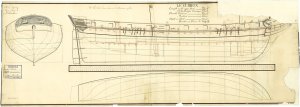
Scale: 1:48. Plan showing the body plan with stern board decoration and name across the counter, the sheer lines with inboard detail and quarter gallery [figurehead missing], and longitudinal half-breadth for Curieux (captured 1804), a captured French Brig as taken off and fitted as an 18-gun Brig Sloop. The ship was at Plymouth to have defects made good between 17 July and 17 October 1805. Signed by Joseph Tucker [Master Shipwright, Plymouth Dockyard, 1802-1813]. The top right corner is missing, including the area around the figurehead.
Read more at http://collections.rmg.co.uk/collections/objects/84038.html#hv0gKmHQRjrAFyV5.99

The action
She sailed from Lorient on 15 August 1808 under the command of Lieutenant de vaisseau Maujouan, and in the company of Diligente, a 20-gun corvette of the French Navy, lead ship of her class and launched 1801, and Sylphe, an Abeille-class 16-gun brig-corvette launched in 1804.

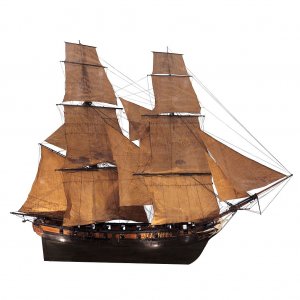
left: French corvette Diligente (1801)
right: 1/36th scale model of Cygne, sister-ship of Sylphe, on display at the Musée national de la Marine in Paris.
The three ships were sailing across the Bay of Biscay en route to Martinique to deliver supplies when they encountered Comet, under Captain Cuthbert Featherstone Daly, on 17 August. HMS Comet soon captured Sylphe but the other two escaped.
The next day Captain Clotworthy Upton in HMS Sybille captured Espiègle. Diligente, though, escaped.
Sibylle was a 38-gun Hébé-class frigate of the French Navy. She was launched in 1791 at the dockyards in Toulon and placed in service in 1792. After the 50-gun fourth rate HMS Romney captured her in 1794, the British took her into service as HMS Sybille. She served in the Royal Navy until disposed of in 1833. While in British service Sybille participated in three notable single ship actions, in each case capturing a French vessel. On anti-slavery duties off West Africa from July 1827 to June 1830, Sybille captured numerous slavers and freed some 3,500 slaves. She was finally sold in 1833 in Portsmouth.

lines & pr NMM, Progress Book, volume 5, folio 582, states that 'Sybille' arrived at Portsmouth Dockyard on 30 November 1794 and was docked on 3 January 1795. She was undocked on 21 January and sailed on 17 April 1795 having been fitted.
Read more at http://collections.rmg.co.uk/collections/objects/82076.html#6Y08AqetMyOPBcxU.99

HMS Sybille capturing the Chiffonne
https://en.wikipedia.org/wiki/French_frigate_Sibylle_(1792)
https://en.wikipedia.org/wiki/HMS_Electra_(1808)
https://en.wikipedia.org/wiki/French_corvette_Diligente_(1801)
https://en.wikipedia.org/wiki/French_corvette_Sylphe_(1804)
Espiègle was a 16-gun brig-sloop of the French Curieux-class . She was built by the Enterprise Ethéart, Saint-Malo, and launched in 1804. She was armed in 1807 at Saint Servan. The British frigate Sybille captured her on 16 August 1808. There was already an Espiegle in the Royal Navy so the Navy took the vessel they had just captured into service as HMS Electra, her predecessor Electra having been wrecked in March. Electra captured one American privateer before she was sold in 1816.

Scale: 1:48. Plan showing the body plan with stern board decoration and name across the counter, the sheer lines with inboard detail and quarter gallery [figurehead missing], and longitudinal half-breadth for Curieux (captured 1804), a captured French Brig as taken off and fitted as an 18-gun Brig Sloop. The ship was at Plymouth to have defects made good between 17 July and 17 October 1805. Signed by Joseph Tucker [Master Shipwright, Plymouth Dockyard, 1802-1813]. The top right corner is missing, including the area around the figurehead.
Read more at http://collections.rmg.co.uk/collections/objects/84038.html#hv0gKmHQRjrAFyV5.99

The action
She sailed from Lorient on 15 August 1808 under the command of Lieutenant de vaisseau Maujouan, and in the company of Diligente, a 20-gun corvette of the French Navy, lead ship of her class and launched 1801, and Sylphe, an Abeille-class 16-gun brig-corvette launched in 1804.


left: French corvette Diligente (1801)
right: 1/36th scale model of Cygne, sister-ship of Sylphe, on display at the Musée national de la Marine in Paris.
The three ships were sailing across the Bay of Biscay en route to Martinique to deliver supplies when they encountered Comet, under Captain Cuthbert Featherstone Daly, on 17 August. HMS Comet soon captured Sylphe but the other two escaped.
The next day Captain Clotworthy Upton in HMS Sybille captured Espiègle. Diligente, though, escaped.
Sibylle was a 38-gun Hébé-class frigate of the French Navy. She was launched in 1791 at the dockyards in Toulon and placed in service in 1792. After the 50-gun fourth rate HMS Romney captured her in 1794, the British took her into service as HMS Sybille. She served in the Royal Navy until disposed of in 1833. While in British service Sybille participated in three notable single ship actions, in each case capturing a French vessel. On anti-slavery duties off West Africa from July 1827 to June 1830, Sybille captured numerous slavers and freed some 3,500 slaves. She was finally sold in 1833 in Portsmouth.

lines & pr NMM, Progress Book, volume 5, folio 582, states that 'Sybille' arrived at Portsmouth Dockyard on 30 November 1794 and was docked on 3 January 1795. She was undocked on 21 January and sailed on 17 April 1795 having been fitted.
Read more at http://collections.rmg.co.uk/collections/objects/82076.html#6Y08AqetMyOPBcxU.99

HMS Sybille capturing the Chiffonne
https://en.wikipedia.org/wiki/French_frigate_Sibylle_(1792)
https://en.wikipedia.org/wiki/HMS_Electra_(1808)
https://en.wikipedia.org/wiki/French_corvette_Diligente_(1801)
https://en.wikipedia.org/wiki/French_corvette_Sylphe_(1804)
16 August 1897 - The ship Belgica under lead of Adrien de Gerlache set sail for the first expedition to winter in the Antarctic region
In 1896, Baron Adrien Victor Joseph de Gerlache de Gomery (2 August 1866 – 4 December 1934), who was an officer in the Belgian Royal Navy , purchased the Norwegian-built whaling ship Patria, which, following an extensive refit, he renamed as the Belgica. With a multinational crew, which included Roald Amundsen, Frederick Cook, Antoni Bolesław Dobrowolski, Henryk Arctowski and Emil Racoviță, he set sail from Antwerp on 16 August 1897.

Pre-purchase inspection of the Belgica. From left to right: de Gerlache, Nansen, Somers, Danco, Amundsen, Bryde, Van Rysselberghe, Andvord.
During January 1898, the Belgica reached the coast of Graham Land. Sailing in between the Graham Land coast and a long string of islands to the west, de Gerlache named the passage Belgica Strait. Later, it was renamed Gerlache Strait in his honor. After charting and naming several islands during some 20 separate landings, they crossed the Antarctic Circle on 15 February 1898.

The Belgica anchored at Mount William
On 28 February 1898, de Gerlache's expedition became trapped in the ice of the Bellinghausen Sea, near Peter Island. Despite efforts of the crew to free the ship, they quickly realised that they would be forced to spend the winter on Antarctica. Several weeks later, on 17 May, total darkness set in, which lasted until 23 July. What followed were another 7 months of hardship trying to free the ship and its crew from the clutches of the ice. Several men lost their sanity, including one Belgian sailor who left the ship "announcing he was going back to Belgium". The party also suffered badly from scurvy.

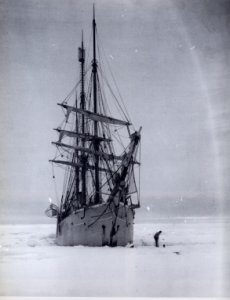

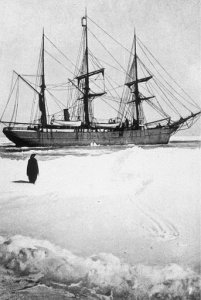
Belgica while trapped in the ice.
Finally, on 15 February 1899, they managed to slowly start down a channel they had cleared during the weeks before. It took them nearly a month to cover 7 miles, and on 14 March they cleared the ice. The expedition returned to Antwerp on 5 November 1899. In 1902, his book Quinze Mois dans l'Antarctique (published in 1901) was awarded a prize by the Académie Française.

https://en.wikipedia.org/wiki/Belgian_Antarctic_Expedition
https://en.wikipedia.org/wiki/Adrien_de_Gerlache
https://en.wikipedia.org/wiki/RV_Belgica_(1884)
In 1896, Baron Adrien Victor Joseph de Gerlache de Gomery (2 August 1866 – 4 December 1934), who was an officer in the Belgian Royal Navy , purchased the Norwegian-built whaling ship Patria, which, following an extensive refit, he renamed as the Belgica. With a multinational crew, which included Roald Amundsen, Frederick Cook, Antoni Bolesław Dobrowolski, Henryk Arctowski and Emil Racoviță, he set sail from Antwerp on 16 August 1897.

Pre-purchase inspection of the Belgica. From left to right: de Gerlache, Nansen, Somers, Danco, Amundsen, Bryde, Van Rysselberghe, Andvord.
During January 1898, the Belgica reached the coast of Graham Land. Sailing in between the Graham Land coast and a long string of islands to the west, de Gerlache named the passage Belgica Strait. Later, it was renamed Gerlache Strait in his honor. After charting and naming several islands during some 20 separate landings, they crossed the Antarctic Circle on 15 February 1898.

The Belgica anchored at Mount William
On 28 February 1898, de Gerlache's expedition became trapped in the ice of the Bellinghausen Sea, near Peter Island. Despite efforts of the crew to free the ship, they quickly realised that they would be forced to spend the winter on Antarctica. Several weeks later, on 17 May, total darkness set in, which lasted until 23 July. What followed were another 7 months of hardship trying to free the ship and its crew from the clutches of the ice. Several men lost their sanity, including one Belgian sailor who left the ship "announcing he was going back to Belgium". The party also suffered badly from scurvy.




Belgica while trapped in the ice.
Finally, on 15 February 1899, they managed to slowly start down a channel they had cleared during the weeks before. It took them nearly a month to cover 7 miles, and on 14 March they cleared the ice. The expedition returned to Antwerp on 5 November 1899. In 1902, his book Quinze Mois dans l'Antarctique (published in 1901) was awarded a prize by the Académie Française.

https://en.wikipedia.org/wiki/Belgian_Antarctic_Expedition
https://en.wikipedia.org/wiki/Adrien_de_Gerlache
https://en.wikipedia.org/wiki/RV_Belgica_(1884)
Other Events on 16 August
1778 - Engagement between British squadron under Sir Edward Vernon and a French squadron under M.Tranjolly off Pondicherry, Coromandel coast.
1805 - HMS Raisonable (1768 - 64) engaged french Gloire-class frigate Topaze (1805 - 40)


https://en.wikipedia.org/wiki/HMS_Raisonnable_(1768)
https://en.wikipedia.org/wiki/French_frigate_Topaze_(1805)
1812 - USS Constitution (44), Cptn. Isaac Hull, recaptures American merchant brig Adeline.
1822 - USS Grampus investigates and pursues a brig flying Spanish colors. When called upon to surrender, the privateer brig Palmyra from Puerto Rico fires cannon and musket fire. USS Grampus fires back on Palmyras broadsides reducing Palmyras rigging to a complete wreck, killing one and wounding six. The brig surrenders with a crew of 88, one long 18-pounder gun and eight 18-pound carronades. Her officers acknowledge they had robbed the American schooner USS Coquette.
1850 - The Danish paddle steamer Hekla, Cdr. Edouard Suensson, of the blockade force outside Kiel, fights the Schleswig-Holstein steamship Løwe and 4 gunboats in the Kiel inlet. 1 gun boat is set on fire.
1858 – U.S. President James Buchanan inaugurates the new transatlantic telegraph cable by exchanging greetings with Queen Victoria of the United Kingdom. However, a weak signal forces a shutdown of the service in a few weeks.
https://en.wikipedia.org/wiki/Transatlantic_telegraph_cable
https://en.wikipedia.org/wiki/James_Buchanan
1863 - During the Civil War, three Union ships, USS Rhode Island, USS De Soto and USS Gertrude each capture steamers loaded with cargoes of turpentine, cotton, tobacco, coffee, cigars and dry goods from the Bahama Islands to the Gulf of Mexico to Cuba.
1913 – Completion of the Royal Navy battlecruiser HMS Queen Mary.

HMS Queen Mary was the last battlecruiser built by the Royal Navy before World War I. The sole member of her class, Queen Mary shared many features with the Lion-class battlecruisers, including her eight 13.5-inch (343 mm) guns. She was completed in 1913 and participated in the Battle of Heligoland Bight as part of the Grand Fleet in 1914. Like most of the modern British battlecruisers, she never left the North Sea during the war. As part of the 1st Battlecruiser Squadron, she attempted to intercept a German force that bombarded the North Sea coast of England in December 1914, but was unsuccessful. She was refitting in early 1915 and missed the Battle of Dogger Bank in January, but participated in the largest fleet action of the war, the Battle of Jutland in mid-1916. She was hit twice by the German battlecruiser Derfflinger during the early part of the battle and her magazines exploded shortly afterwards, sinking the ship.
Her wreck was discovered in 1991 and rests in pieces, some of which are upside down, on the floor of the North Sea. Queen Mary is designated as a protected place under the Protection of Military Remains Act 1986 as it is the grave of 1,266 officers and men.
https://en.wikipedia.org/wiki/HMS_Queen_Mary
1918 – The Battle of Lake Baikal was fought between the Czechoslovak Legion and the Red Army.
The Battle of lake Baikal was probably the only naval battle to be undertaken by Czechoslovak forces.
On the August 15, the Czechoslovak "fleet" sailed out of Listvyanka. By noon on the August 16, the ships were about 8 km from the port in Mysova in heavy fog. After a few minutes, the fog started dissipating and the ships spotted Mysova. The Red Army forces defending the town were under the impression that the approaching ships were friendly vessels bringing in supplies. This allowed the ships to approach the harbor to a distance of approximately 4 km. By the time the defenders of Mysova realized their error, it was too late. The icebreaker Bajkal tried to initiate fire upon the Czechoslovak ships but they were faster. They began to fire, both at the Bajkal and at the harbor. The

Bajkal was sunk and general confusion erupted in Mysova. The train station was in flames. An armored train arrived after half an hour of Czechoslovak bombardment. Guns were offloaded from it and began to return fire upon the Czechoslovak ships. Since the main mission of destroying the harbor and train station were completed, the legionaries left the battle. On the return journey they met the enemy ship Angara which decided to evade battle. The rest of the journey was uneventful and they returned to Listvyanka without any further incidents.
https://en.wikipedia.org/wiki/Battle_of_Lake_Baikal
1942 – World War II: A naval L-class blimp drifts in from the Pacific and eventually crashes in Daly City, California. The two-man crew cannot be found.

https://en.wikipedia.org/wiki/L-class_blimp
1942 – german U-507 sunk 3 neutral brasilian passenger ships killing hundreds of civilians – provoked the Brazilian declaration of war on Germany.
German submarine U-507 was a Type IXC U-boat of Nazi Germany's Kriegsmarine built for service in the Second World War and the Battle of the Atlantic. She was mainly notable for two patrols she conducted during the "Second Happy Time" in mid-1942, during the first of which she caused havoc in the Gulf of Mexico amongst unprotected American shipping, and then in the second she attacked ships along the coast of Brazil, in an inexplicable and shocking attack on a neutral nation's shipping in its own waters which almost single-handedly provoked the Brazilian declaration of war on Germany.
Her third patrol was even more controversial, as a fruitless passage across the Atlantic brought her to the Brazilian coast in mid-August 1942. There she searched for Allied shipping hugging the coastline in Brazilian territorial waters heading for North America. Here she again saw unescorted ships and a lit coastline, and Schacht made the inexplicable decision to attack without first ascertaining the nationalities of her targets. The first was the SS Baependy on 16 August, which was torpedoed and sunk with 270 civilian lives. A few hours later the SS Araraquara was sunk, killing 131 people, followed by the SS Annibal Benevolo, on which 150 civilians drowned. The next day the slaughter continued, the SS Itagiba sunk within sight of the city of Vitória, killing 36, and the SS Arara similarly sunk with 20 deaths as she picked up the survivors of the Itagiba. Two days after this, the tiny sailing vessel Jacyra was sunk, and a Swedish ship was torpedoed three days after that. In just one week, U-507 had sunk seven ships of 18,000 tons and killed over 600 people, all of them neutral civilians
https://de.wikipedia.org/wiki/U_507
1942 - beginning of Operation Wunderland
Operation Wunderland (German: Unternehmen Wunderland) was a large-scale operation undertaken in summer 1942 (16 August – 5 October 1942) by the Kriegsmarine in the waters of the Northern Sea Route close to the Arctic Ocean. The Germans knew that many ships of the Soviet Navy had sought refuge in the Kara Sea because of the protection that its ice pack provided during 10 months of the year. The naval operation to enter the Kara Sea during the summer thaw and destroy as many Russian vessels as possible was named "Operation Wunderland".
http://en.wikipedia.org/wiki/Operation_Wunderland
1945 – Death of Takijirō Ōnishi, Japanese admiral (b. 1891)
Takijirō Ōnishi (大西 瀧治郎 Ōnishi Takijirō, 2 June 1891 – 16 August 1945) was an admiral in the Imperial Japanese Navy during World War II, who came to be known as the father of the kamikaze.
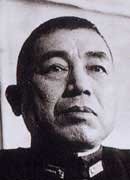

Ōnishi committed ritual suicide (seppuku) in his quarters on 16 August 1945, following the unconditional surrender of Japan at the end of World War II. His suicide note apologized to the approximately 4,000 pilots whom he had sent to their deaths, and urged all young civilians who had survived the war to work towards rebuilding Japan and peace among nations. He also stated that he would offer his death as a penance to the kamikaze pilots and their families. Accordingly, he did not use a kaishakunin (a second who executes him by beheading), and died of self-inflicted injuries over a period of 15 hours.
The sword with which Ōnishi committed suicide is kept at the Yūshūkan Museum in Yasukuni Shrine in Tokyo. Ōnishi′s ashes were divided between two graves – one at the Zen temple of Sōji-ji in Tsurumi, Yokohama, and the other at the public cemetery in former Ashida village in Hyōgo prefecture.
https://en.wikipedia.org/wiki/Takijirō_Ōnishi
1954 - Operation Passage to Freedom begins. The operation transports refugees from Haiphong to Saigon, Vietnam.
1959 – Death William Halsey, Jr., American admiral (b. 1882)
Fleet Admiral William Frederick Halsey Jr., KBE (October 30, 1882 – August 16, 1959),[2] known as Bill Halsey or "Bull" Halsey, was an American admiral in the United States Navy during World War II. He is one of the four individuals to have attained the rank of fleet admiral of the United States Navy.
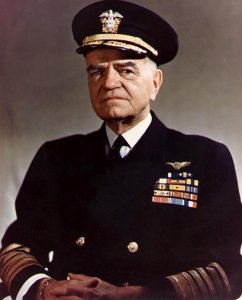
https://en.wikipedia.org/wiki/William_Halsey_Jr.
2013 – The ferry St. Thomas Aquinas collides with a cargo ship and sinks at Cebu, Philippines, killing 61 people with 59 others missing.
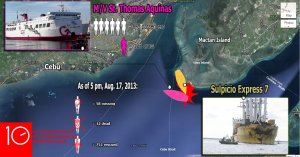

MV St. Thomas Aquinas was a Philippine-registered passenger ferry operated by 2GO Travel. On 16 August 2013, the vessel collided with a cargo ship named MV Sulpicio Express Siete of Philippine Span Asia Carrier Corporation (formerly Sulpicio Lines) causing it to sink. As of 3 September 2013, there were 108 dead and 29 missing with 733 rescued as a result of the accident.
https://en.wikipedia.org/wiki/MV_St._Thomas_Aquinas
1778 - Engagement between British squadron under Sir Edward Vernon and a French squadron under M.Tranjolly off Pondicherry, Coromandel coast.
1805 - HMS Raisonable (1768 - 64) engaged french Gloire-class frigate Topaze (1805 - 40)


https://en.wikipedia.org/wiki/HMS_Raisonnable_(1768)
https://en.wikipedia.org/wiki/French_frigate_Topaze_(1805)
1812 - USS Constitution (44), Cptn. Isaac Hull, recaptures American merchant brig Adeline.
1822 - USS Grampus investigates and pursues a brig flying Spanish colors. When called upon to surrender, the privateer brig Palmyra from Puerto Rico fires cannon and musket fire. USS Grampus fires back on Palmyras broadsides reducing Palmyras rigging to a complete wreck, killing one and wounding six. The brig surrenders with a crew of 88, one long 18-pounder gun and eight 18-pound carronades. Her officers acknowledge they had robbed the American schooner USS Coquette.
1850 - The Danish paddle steamer Hekla, Cdr. Edouard Suensson, of the blockade force outside Kiel, fights the Schleswig-Holstein steamship Løwe and 4 gunboats in the Kiel inlet. 1 gun boat is set on fire.
1858 – U.S. President James Buchanan inaugurates the new transatlantic telegraph cable by exchanging greetings with Queen Victoria of the United Kingdom. However, a weak signal forces a shutdown of the service in a few weeks.
https://en.wikipedia.org/wiki/Transatlantic_telegraph_cable
https://en.wikipedia.org/wiki/James_Buchanan
1863 - During the Civil War, three Union ships, USS Rhode Island, USS De Soto and USS Gertrude each capture steamers loaded with cargoes of turpentine, cotton, tobacco, coffee, cigars and dry goods from the Bahama Islands to the Gulf of Mexico to Cuba.
1913 – Completion of the Royal Navy battlecruiser HMS Queen Mary.

HMS Queen Mary was the last battlecruiser built by the Royal Navy before World War I. The sole member of her class, Queen Mary shared many features with the Lion-class battlecruisers, including her eight 13.5-inch (343 mm) guns. She was completed in 1913 and participated in the Battle of Heligoland Bight as part of the Grand Fleet in 1914. Like most of the modern British battlecruisers, she never left the North Sea during the war. As part of the 1st Battlecruiser Squadron, she attempted to intercept a German force that bombarded the North Sea coast of England in December 1914, but was unsuccessful. She was refitting in early 1915 and missed the Battle of Dogger Bank in January, but participated in the largest fleet action of the war, the Battle of Jutland in mid-1916. She was hit twice by the German battlecruiser Derfflinger during the early part of the battle and her magazines exploded shortly afterwards, sinking the ship.
Her wreck was discovered in 1991 and rests in pieces, some of which are upside down, on the floor of the North Sea. Queen Mary is designated as a protected place under the Protection of Military Remains Act 1986 as it is the grave of 1,266 officers and men.
https://en.wikipedia.org/wiki/HMS_Queen_Mary
1918 – The Battle of Lake Baikal was fought between the Czechoslovak Legion and the Red Army.
The Battle of lake Baikal was probably the only naval battle to be undertaken by Czechoslovak forces.
On the August 15, the Czechoslovak "fleet" sailed out of Listvyanka. By noon on the August 16, the ships were about 8 km from the port in Mysova in heavy fog. After a few minutes, the fog started dissipating and the ships spotted Mysova. The Red Army forces defending the town were under the impression that the approaching ships were friendly vessels bringing in supplies. This allowed the ships to approach the harbor to a distance of approximately 4 km. By the time the defenders of Mysova realized their error, it was too late. The icebreaker Bajkal tried to initiate fire upon the Czechoslovak ships but they were faster. They began to fire, both at the Bajkal and at the harbor. The

Bajkal was sunk and general confusion erupted in Mysova. The train station was in flames. An armored train arrived after half an hour of Czechoslovak bombardment. Guns were offloaded from it and began to return fire upon the Czechoslovak ships. Since the main mission of destroying the harbor and train station were completed, the legionaries left the battle. On the return journey they met the enemy ship Angara which decided to evade battle. The rest of the journey was uneventful and they returned to Listvyanka without any further incidents.
https://en.wikipedia.org/wiki/Battle_of_Lake_Baikal
1942 – World War II: A naval L-class blimp drifts in from the Pacific and eventually crashes in Daly City, California. The two-man crew cannot be found.

https://en.wikipedia.org/wiki/L-class_blimp
1942 – german U-507 sunk 3 neutral brasilian passenger ships killing hundreds of civilians – provoked the Brazilian declaration of war on Germany.
German submarine U-507 was a Type IXC U-boat of Nazi Germany's Kriegsmarine built for service in the Second World War and the Battle of the Atlantic. She was mainly notable for two patrols she conducted during the "Second Happy Time" in mid-1942, during the first of which she caused havoc in the Gulf of Mexico amongst unprotected American shipping, and then in the second she attacked ships along the coast of Brazil, in an inexplicable and shocking attack on a neutral nation's shipping in its own waters which almost single-handedly provoked the Brazilian declaration of war on Germany.
Her third patrol was even more controversial, as a fruitless passage across the Atlantic brought her to the Brazilian coast in mid-August 1942. There she searched for Allied shipping hugging the coastline in Brazilian territorial waters heading for North America. Here she again saw unescorted ships and a lit coastline, and Schacht made the inexplicable decision to attack without first ascertaining the nationalities of her targets. The first was the SS Baependy on 16 August, which was torpedoed and sunk with 270 civilian lives. A few hours later the SS Araraquara was sunk, killing 131 people, followed by the SS Annibal Benevolo, on which 150 civilians drowned. The next day the slaughter continued, the SS Itagiba sunk within sight of the city of Vitória, killing 36, and the SS Arara similarly sunk with 20 deaths as she picked up the survivors of the Itagiba. Two days after this, the tiny sailing vessel Jacyra was sunk, and a Swedish ship was torpedoed three days after that. In just one week, U-507 had sunk seven ships of 18,000 tons and killed over 600 people, all of them neutral civilians
https://de.wikipedia.org/wiki/U_507
1942 - beginning of Operation Wunderland
Operation Wunderland (German: Unternehmen Wunderland) was a large-scale operation undertaken in summer 1942 (16 August – 5 October 1942) by the Kriegsmarine in the waters of the Northern Sea Route close to the Arctic Ocean. The Germans knew that many ships of the Soviet Navy had sought refuge in the Kara Sea because of the protection that its ice pack provided during 10 months of the year. The naval operation to enter the Kara Sea during the summer thaw and destroy as many Russian vessels as possible was named "Operation Wunderland".
http://en.wikipedia.org/wiki/Operation_Wunderland
1945 – Death of Takijirō Ōnishi, Japanese admiral (b. 1891)
Takijirō Ōnishi (大西 瀧治郎 Ōnishi Takijirō, 2 June 1891 – 16 August 1945) was an admiral in the Imperial Japanese Navy during World War II, who came to be known as the father of the kamikaze.


Ōnishi committed ritual suicide (seppuku) in his quarters on 16 August 1945, following the unconditional surrender of Japan at the end of World War II. His suicide note apologized to the approximately 4,000 pilots whom he had sent to their deaths, and urged all young civilians who had survived the war to work towards rebuilding Japan and peace among nations. He also stated that he would offer his death as a penance to the kamikaze pilots and their families. Accordingly, he did not use a kaishakunin (a second who executes him by beheading), and died of self-inflicted injuries over a period of 15 hours.
The sword with which Ōnishi committed suicide is kept at the Yūshūkan Museum in Yasukuni Shrine in Tokyo. Ōnishi′s ashes were divided between two graves – one at the Zen temple of Sōji-ji in Tsurumi, Yokohama, and the other at the public cemetery in former Ashida village in Hyōgo prefecture.
https://en.wikipedia.org/wiki/Takijirō_Ōnishi
1954 - Operation Passage to Freedom begins. The operation transports refugees from Haiphong to Saigon, Vietnam.
1959 – Death William Halsey, Jr., American admiral (b. 1882)
Fleet Admiral William Frederick Halsey Jr., KBE (October 30, 1882 – August 16, 1959),[2] known as Bill Halsey or "Bull" Halsey, was an American admiral in the United States Navy during World War II. He is one of the four individuals to have attained the rank of fleet admiral of the United States Navy.

https://en.wikipedia.org/wiki/William_Halsey_Jr.
2013 – The ferry St. Thomas Aquinas collides with a cargo ship and sinks at Cebu, Philippines, killing 61 people with 59 others missing.


MV St. Thomas Aquinas was a Philippine-registered passenger ferry operated by 2GO Travel. On 16 August 2013, the vessel collided with a cargo ship named MV Sulpicio Express Siete of Philippine Span Asia Carrier Corporation (formerly Sulpicio Lines) causing it to sink. As of 3 September 2013, there were 108 dead and 29 missing with 733 rescued as a result of the accident.
https://en.wikipedia.org/wiki/MV_St._Thomas_Aquinas


